E.G. Wolverson's Blog, page 9
February 28, 2016
Book Review | Star Trek: Voyager - A Pocket Full of Lies by Kirsten Beyer
Of all the
Star Trek
television series, none annoy me more than
Star Trek: Voyager
. Its premise - the crew of a starship marooned some seventy-five-thousand light years from Earth and trying to find their way back home - is arguably even more alluring than that of the original series’ five-year mission of exploration. Yet Voyager failed to capitalise on its potential; so much so that, at times, I struggled to suspend my disbelief. Not only did the ship get through shuttlecraft like there was no tomorrow, but it fired more irreplaceable photon torpedoes than (the writers made a big deal of stressing that) they had; lost many crewmen, yet had an ever-increasing crew complement; and even had the uncanny habit of running into many of the same species time and again - some of them after having put ten or even twenty-thousand light years between their territory and the ship. Such inconsistencies speak to the show’s fundamental failure to deal with consequences - a general failing in episodic television of the time, but Voyager especially so. Indeed, I can think of only a single episode that saw the ship carry damage over from the preceding story, when, really, Voyager should have been a show grounded in attrition. In seven years and 168 episodes, only Captain Janeway’s morals and judgement can claim to have been gradually eroded by circumstance.

 Yet in its fourth season, the show offered us a glimpse of what might have been in its spectacular “Year of Hell” two-parter. Under constant attack for months by the time-altering Krenim, Voyager suffers heavy damage and heavy casualties, bridge officers amongst them. Tuvok is blinded, the captain scarred. Of course, the Year of Hell, the most interesting thing ever to happen to Captain Janeway and her crew, never happened - it was all overwritten in an inevitable deus ex machina that saw the so-called “prime timeline” restored. Only an author as bold and as innovative as Kirsten Beyer, Voyager’s literary showrunner these days, could have both the imagination and the gumption to write a sequel to a story that didn’t happen - and to somehow make both count.
Yet in its fourth season, the show offered us a glimpse of what might have been in its spectacular “Year of Hell” two-parter. Under constant attack for months by the time-altering Krenim, Voyager suffers heavy damage and heavy casualties, bridge officers amongst them. Tuvok is blinded, the captain scarred. Of course, the Year of Hell, the most interesting thing ever to happen to Captain Janeway and her crew, never happened - it was all overwritten in an inevitable deus ex machina that saw the so-called “prime timeline” restored. Only an author as bold and as innovative as Kirsten Beyer, Voyager’s literary showrunner these days, could have both the imagination and the gumption to write a sequel to a story that didn’t happen - and to somehow make both count.

 Whereas the Voyager television series became almost absurd in its eschewing of consequences, A Pocket Full of Lies, much like
The Eternal Tide
before it, is an in-depth exploration of them. The effects of things that never were and may not be are felt as keenly here as the devastating after-effects of the preceding trilogy of novels, as well as The Eternal Tide and even the Borg invasion several years prior. In just a hundred thousand words, Beyer plausibly reconciles the never-was Year of Hell with the Full Circle fleet’s first encounter with the Krenim, while at the same time introducing us to a quantum-duplicate Kathryn Janeway who’s betrayed her oath to Starfleet and is prosecuting an alien war to try to force the enemy into giving up her captured husband and daughter. In the process, she borrows Tuvok from the
Titan
and addresses his feelings about his own lost child, before moving on to deal with Harry and Nancy’s relationship in the wake of her possession by a malevolent alien consciousness in the previous story. She even takes the time to induct the newly-minted Ensign Icheb into the fleet with a charming little sub-plot that quickly sees the youngster learn that he’s a long way to go from knowledge to wisdom.
Whereas the Voyager television series became almost absurd in its eschewing of consequences, A Pocket Full of Lies, much like
The Eternal Tide
before it, is an in-depth exploration of them. The effects of things that never were and may not be are felt as keenly here as the devastating after-effects of the preceding trilogy of novels, as well as The Eternal Tide and even the Borg invasion several years prior. In just a hundred thousand words, Beyer plausibly reconciles the never-was Year of Hell with the Full Circle fleet’s first encounter with the Krenim, while at the same time introducing us to a quantum-duplicate Kathryn Janeway who’s betrayed her oath to Starfleet and is prosecuting an alien war to try to force the enemy into giving up her captured husband and daughter. In the process, she borrows Tuvok from the
Titan
and addresses his feelings about his own lost child, before moving on to deal with Harry and Nancy’s relationship in the wake of her possession by a malevolent alien consciousness in the previous story. She even takes the time to induct the newly-minted Ensign Icheb into the fleet with a charming little sub-plot that quickly sees the youngster learn that he’s a long way to go from knowledge to wisdom.
The story of Denzit Janeway of Sormana is what drives the book, and rightly so. Towards the end of the television series, and in “Year of Hell” in particular, we saw how far Voyager’s then-captain would go for her crew. Here, we see Sormana’s denzit go even further for her real family, before Beyer pulls the rug out from under us to reveal that things aren’t quite as “simple” as they seem. At the time, much was made of Voyager’s creators’ decision to put a woman in the captain’s chair, which is perhaps why the television series’ only ever rarely explored her femininity. Her maternal instincts were always writ large, divided amongst a hundred and forty-odd souls while she herself remained isolated. Well, Denzit Janeway shows what could have happened had she lost her ship and crew only to be rescued from years of torment by a dashing white knight who’d promptly knock her up, making her the only Kathryn Janeway in the multiverse to become a mother. In one of her most touching and terrifying portrayals, Beyer shows us the lines that this denzit would cross to get her daughter back, making our Janeway’s Borg alliances and Hirogen technology handovers seem almost sane in comparison.

What’s most interesting about the denzit though is the reaction that she provokes in others - Tuvok in particular. Circumstances have conspired to push Titan’s tactical officer’s sympathies away from his old friend and towards this quantum echo of her whose pain he shares. I can’t recall an episode or novel that deals with the Vulcan so brilliantly, getting beneath his stoic façade without completely letting it drop.
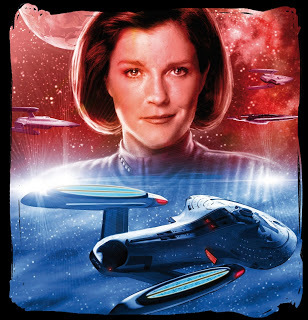 Furthermore, having spent three books in the bureaucratic Confederacy, a novel with the ruthless Krenim as the principal antagonists comes as a welcome change of pace. Though Annorax, Voyager’s “Year of Hell” tormentor, is long-dead, not to mention revered, in the prime timeline, his descendants have not heeded his warnings about the “moods” of time and the danger of making temporal incursions to try to affect precise change. A complex character himself, I’m sure it’s no coincidence that this novel’s Krenim, Agent Dayne, shares Annorax’s passions and flaws. But what makes him even more fascinating is the fact that, unlike Annorax, he’s already got what he wanted from time, and it’s the timeline we already know. As such, the Full Circle fleet can’t look to undo his meddling, but merely understand it, and it’s on this understanding that the plot turns.
Furthermore, having spent three books in the bureaucratic Confederacy, a novel with the ruthless Krenim as the principal antagonists comes as a welcome change of pace. Though Annorax, Voyager’s “Year of Hell” tormentor, is long-dead, not to mention revered, in the prime timeline, his descendants have not heeded his warnings about the “moods” of time and the danger of making temporal incursions to try to affect precise change. A complex character himself, I’m sure it’s no coincidence that this novel’s Krenim, Agent Dayne, shares Annorax’s passions and flaws. But what makes him even more fascinating is the fact that, unlike Annorax, he’s already got what he wanted from time, and it’s the timeline we already know. As such, the Full Circle fleet can’t look to undo his meddling, but merely understand it, and it’s on this understanding that the plot turns.
Another appealing aspect of Lies is how it expounds upon some of the Year of Hell’s most fascinating facets, such as the oft-mentioned but never seen on-screen temporal incursions that Annorax spent centuries planning. In one particularly memorable passage, Beyer takes us inside an incursion, and it’s a much more tangible, physical process than “Year of Hell” implied. Beyer’s imagery is as spectacular as it is chilling.

Coming out of the novel, as ever Beyer leaves threads hanging, the most intriguing and emotive of which concerns the fate of Voyager’s chief engineer, Nancy Conlon, and her on/off lover Harry Kim. Beyer could have glossed over Nancy’s possession in the previous novel with a brief acknowledgement or an aside, as the TV series probably would have, but instead she uses it to push both characters in a new direction that raises a whole host of moral dilemmas in true Trek style while exploring issues that I don’t think any Trek series has ever broached in depth: unwanted pregnancy and long-term, potentially terminal illness.
For me, A Pocket Full of Lies is the first Voyager novel since Admiral Janeway’s resurrection to trounce its Alpha and Beta Quadrant sister series’ offerings. By turns harrowing and bold, Beyer finally makes good on the Year of Hell premise, as well as, I dare say, that of the female captain.
A Pocket Full of Lies is available to download from iTunes for £4.99. Amazon charge the same, and also offer a paperback for £7.99.

 Yet in its fourth season, the show offered us a glimpse of what might have been in its spectacular “Year of Hell” two-parter. Under constant attack for months by the time-altering Krenim, Voyager suffers heavy damage and heavy casualties, bridge officers amongst them. Tuvok is blinded, the captain scarred. Of course, the Year of Hell, the most interesting thing ever to happen to Captain Janeway and her crew, never happened - it was all overwritten in an inevitable deus ex machina that saw the so-called “prime timeline” restored. Only an author as bold and as innovative as Kirsten Beyer, Voyager’s literary showrunner these days, could have both the imagination and the gumption to write a sequel to a story that didn’t happen - and to somehow make both count.
Yet in its fourth season, the show offered us a glimpse of what might have been in its spectacular “Year of Hell” two-parter. Under constant attack for months by the time-altering Krenim, Voyager suffers heavy damage and heavy casualties, bridge officers amongst them. Tuvok is blinded, the captain scarred. Of course, the Year of Hell, the most interesting thing ever to happen to Captain Janeway and her crew, never happened - it was all overwritten in an inevitable deus ex machina that saw the so-called “prime timeline” restored. Only an author as bold and as innovative as Kirsten Beyer, Voyager’s literary showrunner these days, could have both the imagination and the gumption to write a sequel to a story that didn’t happen - and to somehow make both count.
 Whereas the Voyager television series became almost absurd in its eschewing of consequences, A Pocket Full of Lies, much like
The Eternal Tide
before it, is an in-depth exploration of them. The effects of things that never were and may not be are felt as keenly here as the devastating after-effects of the preceding trilogy of novels, as well as The Eternal Tide and even the Borg invasion several years prior. In just a hundred thousand words, Beyer plausibly reconciles the never-was Year of Hell with the Full Circle fleet’s first encounter with the Krenim, while at the same time introducing us to a quantum-duplicate Kathryn Janeway who’s betrayed her oath to Starfleet and is prosecuting an alien war to try to force the enemy into giving up her captured husband and daughter. In the process, she borrows Tuvok from the
Titan
and addresses his feelings about his own lost child, before moving on to deal with Harry and Nancy’s relationship in the wake of her possession by a malevolent alien consciousness in the previous story. She even takes the time to induct the newly-minted Ensign Icheb into the fleet with a charming little sub-plot that quickly sees the youngster learn that he’s a long way to go from knowledge to wisdom.
Whereas the Voyager television series became almost absurd in its eschewing of consequences, A Pocket Full of Lies, much like
The Eternal Tide
before it, is an in-depth exploration of them. The effects of things that never were and may not be are felt as keenly here as the devastating after-effects of the preceding trilogy of novels, as well as The Eternal Tide and even the Borg invasion several years prior. In just a hundred thousand words, Beyer plausibly reconciles the never-was Year of Hell with the Full Circle fleet’s first encounter with the Krenim, while at the same time introducing us to a quantum-duplicate Kathryn Janeway who’s betrayed her oath to Starfleet and is prosecuting an alien war to try to force the enemy into giving up her captured husband and daughter. In the process, she borrows Tuvok from the
Titan
and addresses his feelings about his own lost child, before moving on to deal with Harry and Nancy’s relationship in the wake of her possession by a malevolent alien consciousness in the previous story. She even takes the time to induct the newly-minted Ensign Icheb into the fleet with a charming little sub-plot that quickly sees the youngster learn that he’s a long way to go from knowledge to wisdom.The story of Denzit Janeway of Sormana is what drives the book, and rightly so. Towards the end of the television series, and in “Year of Hell” in particular, we saw how far Voyager’s then-captain would go for her crew. Here, we see Sormana’s denzit go even further for her real family, before Beyer pulls the rug out from under us to reveal that things aren’t quite as “simple” as they seem. At the time, much was made of Voyager’s creators’ decision to put a woman in the captain’s chair, which is perhaps why the television series’ only ever rarely explored her femininity. Her maternal instincts were always writ large, divided amongst a hundred and forty-odd souls while she herself remained isolated. Well, Denzit Janeway shows what could have happened had she lost her ship and crew only to be rescued from years of torment by a dashing white knight who’d promptly knock her up, making her the only Kathryn Janeway in the multiverse to become a mother. In one of her most touching and terrifying portrayals, Beyer shows us the lines that this denzit would cross to get her daughter back, making our Janeway’s Borg alliances and Hirogen technology handovers seem almost sane in comparison.

What’s most interesting about the denzit though is the reaction that she provokes in others - Tuvok in particular. Circumstances have conspired to push Titan’s tactical officer’s sympathies away from his old friend and towards this quantum echo of her whose pain he shares. I can’t recall an episode or novel that deals with the Vulcan so brilliantly, getting beneath his stoic façade without completely letting it drop.
 Furthermore, having spent three books in the bureaucratic Confederacy, a novel with the ruthless Krenim as the principal antagonists comes as a welcome change of pace. Though Annorax, Voyager’s “Year of Hell” tormentor, is long-dead, not to mention revered, in the prime timeline, his descendants have not heeded his warnings about the “moods” of time and the danger of making temporal incursions to try to affect precise change. A complex character himself, I’m sure it’s no coincidence that this novel’s Krenim, Agent Dayne, shares Annorax’s passions and flaws. But what makes him even more fascinating is the fact that, unlike Annorax, he’s already got what he wanted from time, and it’s the timeline we already know. As such, the Full Circle fleet can’t look to undo his meddling, but merely understand it, and it’s on this understanding that the plot turns.
Furthermore, having spent three books in the bureaucratic Confederacy, a novel with the ruthless Krenim as the principal antagonists comes as a welcome change of pace. Though Annorax, Voyager’s “Year of Hell” tormentor, is long-dead, not to mention revered, in the prime timeline, his descendants have not heeded his warnings about the “moods” of time and the danger of making temporal incursions to try to affect precise change. A complex character himself, I’m sure it’s no coincidence that this novel’s Krenim, Agent Dayne, shares Annorax’s passions and flaws. But what makes him even more fascinating is the fact that, unlike Annorax, he’s already got what he wanted from time, and it’s the timeline we already know. As such, the Full Circle fleet can’t look to undo his meddling, but merely understand it, and it’s on this understanding that the plot turns.Another appealing aspect of Lies is how it expounds upon some of the Year of Hell’s most fascinating facets, such as the oft-mentioned but never seen on-screen temporal incursions that Annorax spent centuries planning. In one particularly memorable passage, Beyer takes us inside an incursion, and it’s a much more tangible, physical process than “Year of Hell” implied. Beyer’s imagery is as spectacular as it is chilling.

Coming out of the novel, as ever Beyer leaves threads hanging, the most intriguing and emotive of which concerns the fate of Voyager’s chief engineer, Nancy Conlon, and her on/off lover Harry Kim. Beyer could have glossed over Nancy’s possession in the previous novel with a brief acknowledgement or an aside, as the TV series probably would have, but instead she uses it to push both characters in a new direction that raises a whole host of moral dilemmas in true Trek style while exploring issues that I don’t think any Trek series has ever broached in depth: unwanted pregnancy and long-term, potentially terminal illness.
For me, A Pocket Full of Lies is the first Voyager novel since Admiral Janeway’s resurrection to trounce its Alpha and Beta Quadrant sister series’ offerings. By turns harrowing and bold, Beyer finally makes good on the Year of Hell premise, as well as, I dare say, that of the female captain.
A Pocket Full of Lies is available to download from iTunes for £4.99. Amazon charge the same, and also offer a paperback for £7.99.
Published on February 28, 2016 14:06
February 11, 2016
Spoiler-Light TV Review | The X-Files: "My Struggle"
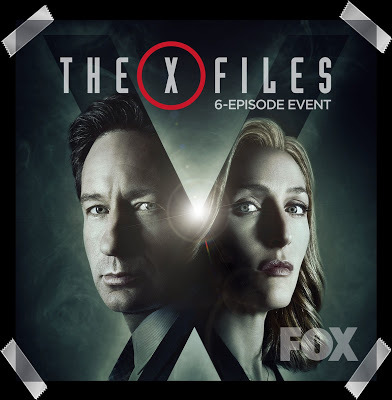 “Thirteen years after the original series run, the next mind-bending chapter of THE X-FILES is a thrilling, six-episode event series from creator/executive producer Chris Carter, with stars David Duchovny and Gillian Anderson re-inhabiting their roles as iconic FBI Agents FOX MULDER and DANA SCULLY.” - FOX
“Thirteen years after the original series run, the next mind-bending chapter of THE X-FILES is a thrilling, six-episode event series from creator/executive producer Chris Carter, with stars David Duchovny and Gillian Anderson re-inhabiting their roles as iconic FBI Agents FOX MULDER and DANA SCULLY.” - FOXI was bloody annoyed when The X-Files was reissued in HD in December - largely because I’d spent the early part of last year re-watching every single episode on DVD in readiness for this month’s six-episode “event series”, and I’ll be damned if I’m watching them again for at least another five or six years. Nevertheless, losing myself again in even the standard-def supernatural casebook of FBI Special Agents Fox Mulder and Dana Scully, which was first opened over two decades ago, I was still reminded what an “event” each week’s episode used to be; it was very much the highlight of my teenage week during the show’s halycon days of its seminal second and third seasons. The show had its own unique look, its own unique sound… even its own subject matter, which quickly became far from unique as it ran roughshod over pop culture, prompting countless cash-in alien autopsy programmes and so-called “real” X-file documentaries. Now The X-Files is back, and to both its credit and its detriment, it’s exactly the same.
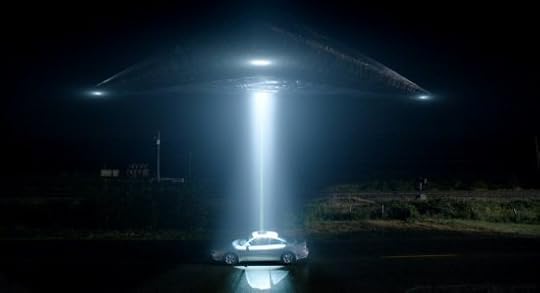
Almost fourteen years ago, The X-Files ran into its dramatic end in the feature-length finale, “The Truth”. The series’ desolate conclusion left our heroes as outlaws on the run from the bureau that they once served, and set the stage for the extraterrestrial colonisation of Earth in 2012. Many fans of the show, myself amongst them, expected FOX to tie up the show’s lauded mythology with a big-budget feature film in or around 2012 – something somewhere between 1998’s The X-Files: Fight the Future and mass-market blockbuster movies the like of Independence Day. Of course, that wouldn’t have been very X-Files, and with a budget decreasing in sync with the show’s profile, showrunner Chris Carter decided to make his 2008 X-Files movie, I Want to Believe, a touching coda to the will they / won’t they / did they? Mulder and Scully relationship, rather than what would have surely been a cheap attempt to tie-up almost a decade’s worth of mythology. Couched in the mould of the series’ famed “monster of the week” episodes, I Want to Believe was unfairly hammered by almost all of the few who bothered to see it, driving what I thought would be the final nails into the series’ coffin lid.
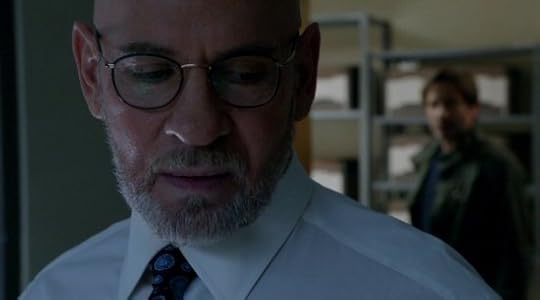
And so after having my hopes all but extinguished, I was incredibly excited at the prospect of The X-Files being closed properly; the prospect of the world either being saved or damned as the colonisation prophesised by “The Truth” began. “My Struggle”, however, is not what I expected. Texturally it has the feel of an old-school X-Files episode – its pace, its style, even its sweeping voiceovers and poorly upscaled title sequence (which seems to drop frames all over the place in the iTunes download) all reek of the once beloved show. I’d half-expected the series to conform to modern stylistics; to layer its sprawling story over its short season, as opposed to telling six stand-alone tales, but Carter has been uncompromising in his vision. Whether this pleases or disappoints is in the eye of the beholder, but I was certainly expecting something… more.
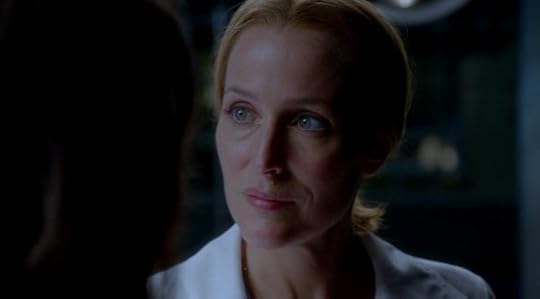
 Yet, rather ironically given the above, “My Struggle” looks to draw a line under the whole X-Files story to date, dismissing its celebrated canon of mythology in favour of an easy-to-resolve, man-made conspiracy that, admittedly, is unlikely to deter new and casual viewers – but only at the expense of long-time X-Philes looking for a satisfying resolution. Granted, the series has thrown us curveballs before, fourth-season finale “Gethsemane” being a case in point, but the retcon feels different this time. With the script citing everything from constitutional violations in the name of defence to increasingly violent and unpredictable weather in support of its new conspiracy, the series’ change in direction is as much a change in tone as it is devilish detail. Unlike the unyielding format of the twenty-year-old series that houses it, “My Struggle” is very much a contemporary piece.
Yet, rather ironically given the above, “My Struggle” looks to draw a line under the whole X-Files story to date, dismissing its celebrated canon of mythology in favour of an easy-to-resolve, man-made conspiracy that, admittedly, is unlikely to deter new and casual viewers – but only at the expense of long-time X-Philes looking for a satisfying resolution. Granted, the series has thrown us curveballs before, fourth-season finale “Gethsemane” being a case in point, but the retcon feels different this time. With the script citing everything from constitutional violations in the name of defence to increasingly violent and unpredictable weather in support of its new conspiracy, the series’ change in direction is as much a change in tone as it is devilish detail. Unlike the unyielding format of the twenty-year-old series that houses it, “My Struggle” is very much a contemporary piece.
Of course, that’s not to say that “My Struggle” isn’t a gripping drama, or even good X-Files episode. Visually, the show has never done a better job of portraying alien bodies and ships – its pre-title montage alone is peppered with breathtaking UFO sightings and engagements, and that’s before we even get to the meat of the matter and the episode’s fiery resolution. More importantly though, the performances of the story’s two supporting stars, and particularly the returning regulars, are unreservedly excellent, Carter’s script beautifully building upon the emotional turmoil of I Want to Believe and thus giving the cast some incredible material to work with. Whilst Gillian Anderson’s ineradicable good looks belie the hell that her character has been through since we last saw her, David Duchovny’s Mulder is most definitely looking weathered. Unshaven and unkempt, the former agent’s depression and obsession have driven a wedge between him and his former partner - a wedge that this episode really drives in through the pair’s dealings with TV host and wannabe whistleblower, Tad O’Malley, before slowly and painfully pulling it out.
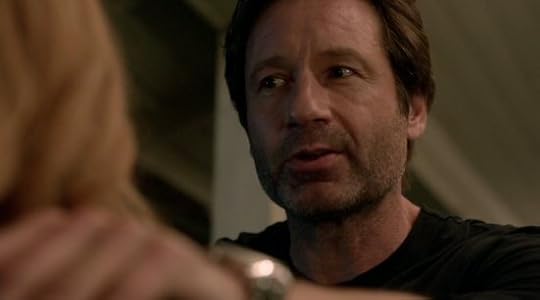
And so the truth is still out there, but it seems to have changed – only its packaging remains the same. “My Struggle”, and I suspect the whole “event series”, will live and die as such.
The X-Files’ six-episode event series is available to download from iTunes in 1080p HD for £12.99. Episodes drop on a Tuesday morning in the UK following broadcast on Channel 5 the night before.
Published on February 11, 2016 05:13
February 9, 2016
The Anti-Inflammatory Cookbook | New-tella Pro Chocolate Hazelnut Spread
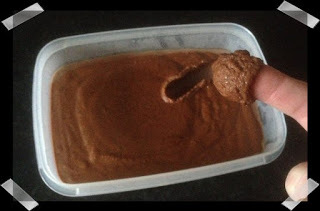 Since posting my New-tella recipe last year, I’ve been hard at work refining it to try to make it more nutritious and less reliant on extraneous ingredients. At last, I’ve succeeded. Its distinctive taste is still present and correct, but it now also packs a protein punch that makes the indulgence at least a little more justifiable – particularly if it’s spread on top of one of my post-workout PrOAT Cakes. Introducing New-tella Pro – a protein-rich, Nutella®-like chocolate and hazelnut spread that’s perfect for pancakes, but far easier to make.
Since posting my New-tella recipe last year, I’ve been hard at work refining it to try to make it more nutritious and less reliant on extraneous ingredients. At last, I’ve succeeded. Its distinctive taste is still present and correct, but it now also packs a protein punch that makes the indulgence at least a little more justifiable – particularly if it’s spread on top of one of my post-workout PrOAT Cakes. Introducing New-tella Pro – a protein-rich, Nutella®-like chocolate and hazelnut spread that’s perfect for pancakes, but far easier to make. 200g whole hazelnuts [£1.79]
200g whole hazelnuts [£1.79]25g cocoa [I’d recommend Cadbury’s Bourneville as the ingredients are limited to cocoa. You can usually get it for about £2.00 per 250g, so 20p]
300ml skimmed milk [89p per 2.72l, so 10p]
125g clear honey [99p for 340g, so 36p]
150g Bulk Powders pure whey isolate unflavoured powder [£46.79 per 5kg, so £1.40]
TOTAL COST TO MAKE ONE BATCH (APPROXIMATELY 20 SERVINGS):
£1.79 + £0.20+ £0.10 + £0.36 + £1.40 = £3.85
TOTAL COST PER SERVING: £0.19


 ONE
ONEPre-heat the oven to 180°c.
TWO
Tip the hazelnuts onto a baking tray and roast them in the oven for 10-12 minutes.
THREE
Add all the ingredients to the blender. The roasted hazelnuts should go in last for best results.
FOUR
Blend the ingredients until the spread is as thick as you like it. The longer you blend the mixture, the more paste-like it will become. I find that it reaches the consistency of Nutella® within about a minute.

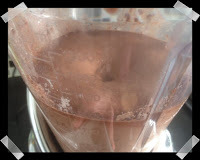
Published on February 09, 2016 02:47
February 4, 2016
Technology Review | Apple TV (Fourth Generation) by Apple Inc
 I learned long ago that, as peerless as their products generally are, it pays to wait before upgrading to whatever new device or operating system it is that Apple are pushing. From time to time, their updates squash one bug only to unleash several more; their newer devices, meanwhile, have a troubling predisposition towards restricting their users’ control over certain functions while enforcing library-confusing “store integration”. Whilst I’ve no objection to buying apps and media from Apple, I have no interest in most streaming services and I don’t want the total sum of the iTunes Store’s catalogue mixed in with my own painstakingly organised iTunes library. It was with some caution, then, that I finally approached the long-awaited fourth generation of Apple TV.
I learned long ago that, as peerless as their products generally are, it pays to wait before upgrading to whatever new device or operating system it is that Apple are pushing. From time to time, their updates squash one bug only to unleash several more; their newer devices, meanwhile, have a troubling predisposition towards restricting their users’ control over certain functions while enforcing library-confusing “store integration”. Whilst I’ve no objection to buying apps and media from Apple, I have no interest in most streaming services and I don’t want the total sum of the iTunes Store’s catalogue mixed in with my own painstakingly organised iTunes library. It was with some caution, then, that I finally approached the long-awaited fourth generation of Apple TV. 
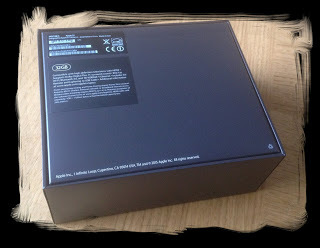 Once nothing more than a Steve Jobs hobby horse, the third generation of Apple’s unassuming black box has served me and my family well since late 2012, all but eradicating our reliance on disc-based media. In fact, I found it hard to see how it could possibly be improved upon at all, save for perhaps loading our media library a little faster or embracing cross-media playlists. Indeed, I held out from upgrading until now as the vast majority of the box’s reviews have focused on the flashy new features that I care little about – little or nothing has been said about the fundamental features that I do. Well, that’s about to change...
Once nothing more than a Steve Jobs hobby horse, the third generation of Apple’s unassuming black box has served me and my family well since late 2012, all but eradicating our reliance on disc-based media. In fact, I found it hard to see how it could possibly be improved upon at all, save for perhaps loading our media library a little faster or embracing cross-media playlists. Indeed, I held out from upgrading until now as the vast majority of the box’s reviews have focused on the flashy new features that I care little about – little or nothing has been said about the fundamental features that I do. Well, that’s about to change...
Physically, the unit is about twice as thick its predecessor, presumably to accommodate the its new 32GB / 64GB disc space. As ever, Apple package it beautifully inside a luxurious obsidian box that doesn’t have to be torn open or half-destroyed to get at what’s inside, and if you buy from them directly you’ll also get a first-class service in which their couriers will text you a one-hour window that they’ll deliver within (they told me from 7:58am this morning, and the parcel arrived at 8:01. Take that, Amazon Prime). My only complaint about the ordering and delivery process was that I deliberately waited until after the 6pm despatch deadline on Tuesday to place my order, so that it’d be delivered today rather than yesterday, when I was out at work. Apple being Apple, though, they only went and pulled out all the stops to get it despatched in time for a delivery yesterday even though I’d deliberately missed their 6pm “next-day delivery” deadline. This meant that I had to contact their couriers to re-arrange delivery for today, which annoyed me. If I order after a deadline, it’s for a reason; I’m not a chimp.

Having opened the box up, I was pleased to find that I could simply unplug the power and HDMI cables from the back of my existing Apple TV and switch the units around (old Gen Three is being relegated to the master bedroom). I didn’t relish the prospect of dismounting an alcove-mounted TV and then trying to pull cables and plugs up through narrow canyons in the wall behind it without damaging them, so this was a major windfall for me. Almost as welcomely, the Apple TV was up and running in less than five minutes – it even obtained the necessary Wi-Fi password and “Home Sharing” settings directly from my iPhone via Bluetooth. Fair dues, I had to later alter the Wi-Fi network when I realised that it had connected to my slower iPhone / iPad / MacBook 2.4GHz network rather than my Apple TV-exclusive 5GHz network, but this was easily fixed.

Another relief was finding that I didn’t have to upgrade my media centre to the latest, store-integrated version of iTunes in order to connect to its iTunes library. I’d been really concerned about this beforehand, and couldn’t find any firm guidance on the point in other online reviews, so let it be known: I’m running iTunes 11.4.0.18 on my media centre and the new Apple TV connects to it quickly and without any fuss.
Once connected to Wi-Fi, the first thing to strike me about the setup was the new “Touch remote”. It’s larger, and with far more buttons than its metallic forerunner (seven, if you count the invisible touch-pad button). Having grown so used to just two buttons and a dial, I was as overwhelmed as a nonagenarian in front of a PC keyboard. Amongst the new buttons is a volume control that, without any setting up, alters my television set’s volume directly. Combined with the device’s automatic turning on and off of my telly along with itself, this neatly dispenses with the need for me to keep my TV’s comparatively colossal remote control within reach (it’s not as if we ever change the channel from Apple TV. Who watches broadcast TV these days?)

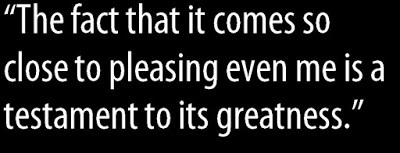 There’s also the much-hyped Siri button, which when held down listens to what you say and then scours online media providers (except for the enemy Amazon, obviously) to find it for you. This is an impressive weapon to deploy if you’re a frequent Netflix user, for instance, or are just after a Saturday-night movie to rent or buy from iTunes. If you say, “Show me a good film from the last year,” it really will present you with a selection of critically-acclaimed movies from the last twelve months. But what I was interested in was its ability to search and retrieve media from my own iTunes library. When I say “
Breaking Bad
” to Siri, for instance, I don’t want her to give me the options of either subscribing to Netflix to watch it or streaming it from my “Purchased” account within the iTunes Store online – I want it to take me to
Breaking Bad
in my own iTunes library on my media centre. Not only would this save me using up precious gigabytes’ download allowance and allow me to keep accurate play counts, but it’d also allow me to see the episodes as I’ve re-tagged and sorted† them, with my own custom artwork and all the spelling mistakes and typos corrected in the episode descriptions.
There’s also the much-hyped Siri button, which when held down listens to what you say and then scours online media providers (except for the enemy Amazon, obviously) to find it for you. This is an impressive weapon to deploy if you’re a frequent Netflix user, for instance, or are just after a Saturday-night movie to rent or buy from iTunes. If you say, “Show me a good film from the last year,” it really will present you with a selection of critically-acclaimed movies from the last twelve months. But what I was interested in was its ability to search and retrieve media from my own iTunes library. When I say “
Breaking Bad
” to Siri, for instance, I don’t want her to give me the options of either subscribing to Netflix to watch it or streaming it from my “Purchased” account within the iTunes Store online – I want it to take me to
Breaking Bad
in my own iTunes library on my media centre. Not only would this save me using up precious gigabytes’ download allowance and allow me to keep accurate play counts, but it’d also allow me to see the episodes as I’ve re-tagged and sorted† them, with my own custom artwork and all the spelling mistakes and typos corrected in the episode descriptions.Incidentally, something that deterred me from taking the plunge sooner were reports that users like me, who’ve lost hours re-tagging every single item in their iTunes libraries, could no longer see their unique episode / movie descriptions on the new Apple TV. Either this issue has been fixed in an update since they flagged this up, or those users had only edited their files’ “Short Description” field within iTunes itself, as opposed to amending their “Long Description” field using third-party software (like MetaX). In line with iOS 9, the fourth generation’s tvOS actually goes further than the third did in displaying the “Long Description” for every meticulously-edited item in my library.

Furthermore, after some playing around, I’ve found that if you drill down into your own library’s menus – “Movies”, for instance – and then use Siri to say the full name of a film in there, it will start playing it; similarly, in “TV Shows”, it will take you to the most recent season of the series that you say. Now that’s useful, but with future updates I’d still like to see items retrieved from my own library when I access Siri from the main menu. Even if they were to appear as a third option behind the iTunes Store and Netflix, it’d do for me.
Something else that I was curious about were playlists. I love ’em, but I seem to be on my own when it comes to visual media. As with the previous version of Apple TV, I had to opt-in to accessing my playlists for non-music media, and even now I still can’t play a full playlist through if it contains different types of media. This continues to infuriate me, but at least I’m no worse off than I was with the third-generation box. In fact, as one TV episode now finishes and the next begins to play automatically, as in iOS 9, I’m actually a little better off as I can do away with many of my daughter’s straightforward TV playlists, which I’d only made to avoid having to jump up every five minutes to press play.
The fourth-gen box has absolutely wowed me in some unexpected areas too. General performance is unreservedly excellent – my large library loads in seconds, and media plays almost instantaneously, as if it were stored on the device itself to begin with rather than beamed and buffered. I started to play an extended episode of Star Wars Rebels in 1080p (“The Siege of Lothal”, which sees James Earl Jones reprise his role as Darth Vader throughout the whole episode) and paused it after ten seconds to see how much of it had been buffered, and it was about three-quarters loaded. Even for my 5Ghz network, that’s fast.
There’s also a fantastic audio tweak that was absent on the previous device – you can choose to limit loud sounds, which is ideal if you’re watching a movie late at night when everyone else is in bed. There’s nothing worse than having to keep turning it up to hear dialogue and then hurriedly turning it down whenever a bomb goes off – in that situation, I always lacked the Jedi-like reflexes not to wake the family. The tvOS interface is slicker too – it’s iOS 9-white, and everything blends and slides and feels super-slick. If you’re watching something and swipe down to read its description or toggle the audio / subtitles settings, the box smoothly slides down rather than just popping up as it did with the last model.

Best of all though are the apps. Apple’s marketing of the new Apple TV has been built around apps, and I see why – these days everyone is streaming and gaming, there’s an app for everything on our phones and tablets, so why not our tellies too? The last version of Apple TV had certain apps pre-installed, while others were automatically downloaded whenever the firmware was updated, which for a curmudgeon like me meant going to great labours to hide the various NFL and BBC News apps that I was never, ever going to use. This new version, though, allows you to download what you want – and only what you want – from the App Store. The only apps that you’re stuck with are the ineradicable iTunes Store links, but even these can be moved out of sight if you hold down the play/pause button and then use the pad to rearrange them. I was therefore able to download the few apps that I’ll actually use – BBC iPlayer now amongst them! – and have these set out alphabetically along the top row, along with the orange “Computers” link to my iTunes library, which means that the shortcuts that now automatically populate the top half of the screen aren’t advertising trending movies that I have no interest in, but offering quick links to the eclectic mix of children’s and adult’s cartoons that account for almost all of our recent family viewing.
There’s no doubting that this latest incarnation of Apple TV has once again made Apple a player in the media player market, and I have little doubt that it’ll become a market leader on the strength of its distinctive features that are tailored to most of today’s consumers. Obviously, I’m not one of them – I’m a fastidious, easy-to-irritate and borderline obsessive geek who needs the box that buffers his media library to do it exactly how he wants it to, and not how someone else thinks that he’ll probably want it to. The fact that it comes so close to pleasing even me is a testament to its greatness.
Apple TV is available directly from Apple Inc from £129.00 including free delivery.
† I noticed in the iTunes Store that someone had actually given the Star Wars Digital Movie Collection a poor review on the basis that the six Star Wars movies appear in alphabetical order in his iTunes library, as opposed to chronologically or even in release order. Whilst for serious librarians I’d recommend getting hold of some decent third-party software like MetaX, which gives you complete control over your iTunes files’ metadata (DRM-protected or not, you can still amend those tags - there’s no law against it!), you can very simply alter a file’s “Sort Name” by right-clicking on it in your iTunes library, pressing “Get Info”, going to the “Sorting” tab, and then altering the “Sort Name” to, say, “Star Wars Episode 4” and so on. You can then label The Clone Wars movie as “Star Wars Episode 2.5” and, once it’s out on home video next year, Rogue One: A Star Wars Story as “Star Wars Episode 3.5”. Alternatively, go for “Star Wars 1977” etc to see the films listed in release order.
Published on February 04, 2016 07:21
Takara Tomy Transformers Masterpiece Review | MP-10: Convoy [Optimus Prime] from The Transformers “Generation One” Animated Series

My greatest treat this last Christmas was unboxing Takara Tomy’s acclaimed MP-10 Convoy - a literal masterpiece of a toy that my parents had imported from Japan, using the Internet to achieve what they could not in 1988. That year, my poor old mam scoured just about every major toy shop in South Yorkshire in search of the original Convoy (Optimus Prime to us in the Western World), oblivious to the fact that it had been discontinued by Hasbro, who were pushing a brand new Transformers toy line following the much-loved Autobot leader’s death on screen. That Christmas, Santa brought me Ultra Magnus.

Takara Tomy’s Masterpiece series is aimed squarely at the now fully-grown men who grew up playing with Transformers. Meticulously engineered to be as poseable and TV-accurate as possible, the range’s transforming action figures plug the gap once filled by childhood imagination. This Optimus looks almost exactly as he did on screen in The Transformers ; his appearance is close to flawless. To see him stood beside his G1 and G1 Powermaster predecessors is to wonder at a child’s ability to suspend disbelief - the 1980s toys bore only the crudest of resemblances to the Cybertron commander, while the Masterpiece is exactly that.

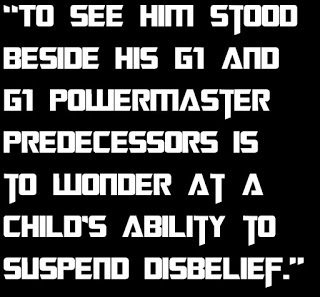 And the Masterpiece’s functionality is breathtaking. Legs that bend would have been an improvement on the Powermaster iteration, but the Masterpiece is so damned flexible that everything from head antennae to individual fingers can be manipulated. This guy can nod, shake hands, point. He comes with a vibro-axe that, once attached, seems to grow straight out of his arm, just like on TV. He not only has a solid back, but a solid back in which his fold-up blaster can be stowed. Best of all though, in a beautiful nod to
The Transformers: The Movie
, his chest opens up to reveal a die-cast chamber housing a bejewelled Autobot Matrix of Leadership. The trade-off for this little wonder is the loss of a truly glass-like appearance for the truck windows that make up the robot’s chest. I’d have been tempted to tint them to hide the chamber beneath.
And the Masterpiece’s functionality is breathtaking. Legs that bend would have been an improvement on the Powermaster iteration, but the Masterpiece is so damned flexible that everything from head antennae to individual fingers can be manipulated. This guy can nod, shake hands, point. He comes with a vibro-axe that, once attached, seems to grow straight out of his arm, just like on TV. He not only has a solid back, but a solid back in which his fold-up blaster can be stowed. Best of all though, in a beautiful nod to
The Transformers: The Movie
, his chest opens up to reveal a die-cast chamber housing a bejewelled Autobot Matrix of Leadership. The trade-off for this little wonder is the loss of a truly glass-like appearance for the truck windows that make up the robot’s chest. I’d have been tempted to tint them to hide the chamber beneath.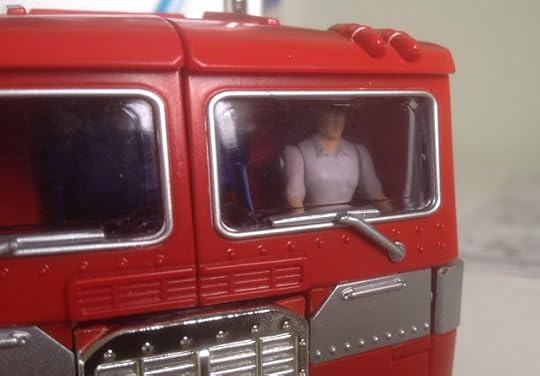
In alt-form, that famous red truck cab is more detailed than ever before - there’s even room to insert the set’s small Spike Witwicky action figure into the driver’s seat. One slight blemish is the robot head, which can be seen hanging upside-down and back-to-front from the roof of the cab like a high-tech alternative to fluffy dice. I certainly don’t remember that on the telly. Again, tinting the windows would have effectively solved this, though admittedly it would have taken something away not to actually be able to see Spike at the wheel.

The alt-form trailer gleams, and can be opened to reveal not only Roller but also various weapons stations; banks of Spike-scaled computer terminals; and even what can be transformed into a vertical regeneration chamber for the proto-form Prime. It boasts more features than the Powermaster’s battle station alt-form, and that’s really saying something.

If this toy has a weakness, it’s that it’s not really fit to be used as such. The transformation process is involved and laborious; a stark contrast to the original’s delightfully straightforward change, which could be effected in less than the time it took to make the commensurate noise. I don’t see this as a major issue though as, doubtless, these Transformers are clearly intended as display pieces rather than snot-and-toybox fodder.

What bothers me more is the figure’s apparent frailty. Poseable fingers are great, but one of them nearly gave me a heart attack when it fell off; the same applies to a small part of the cab’s silver livery, which came away during the transformation. Both were re-attached with ease, fortunately, as modern Transformers have almost as much in common with LEGO as they do their often stiff and breakable ’80s ancestors, but it’s still something of a cause for concern as an inadvertently removed finger could easily be lost – it’s only a few mm thick, after all.

Takara Tomy’s beautiful and sturdy black box proclaims this Masterpiece as the “PERFECT NEW MODEL” Convoy, and it’s hard to disagree. What I have here is a truly optimal Optimus; a phenomenal toy that I don’t need to put on rose-tinted specs to enjoy, as the wonder that I remember so well is all here now, in the flesh – or, rather, the metal.

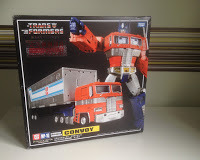

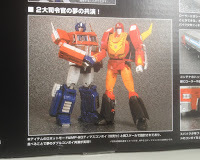
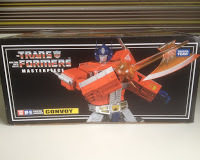
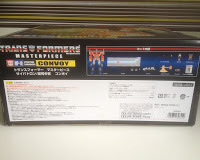

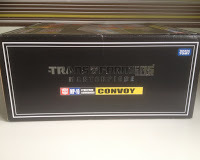

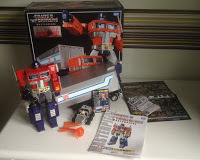
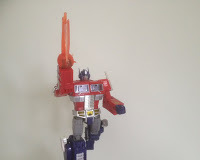
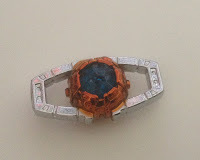
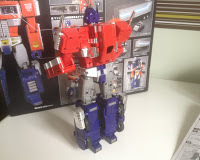
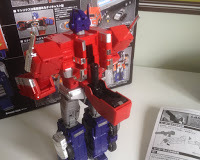
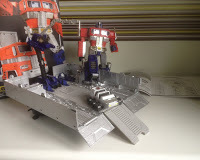
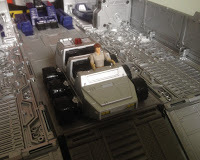
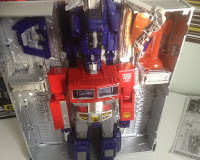
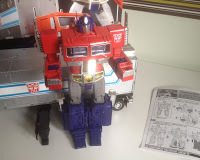
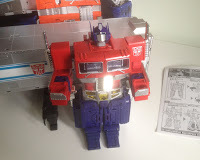

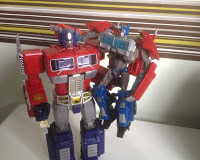
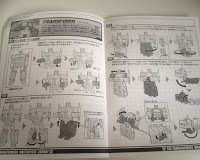
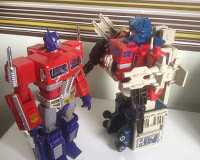
Published on February 04, 2016 05:54
January 31, 2016
First-hand Fitness #7 | On Shredding: A Review of Jillian Michaels’ 30 Day Shred Series
 Last summer the missus bought Jillian Michaels’ 30 Day Shred on the recommendation of a colleague of hers - the same one who sold me the C9 aloe detox. Equally lauded and feared, the Shred comprises three short workouts, each “level” more difficult than the last and all of them combining resistance training and cardio in an attempt to make its formerly portly subjects “shredded”. The wife and I intermittently did Level 1 together through last July and August until I was injured; I was keen to encourage her keep-fit-at-home efforts, having cancelled her infrequently-used gym membership in a fit of thriftiness, but was still fearful that our shared workout was going to be as uninspiring and annoying as her many Davina McCall exercise DVDs. Fortunately I was immediately impressed with Jillian’s intense fusion of strength training; cardio; and abs torture, but unfortunately injury prevented me from going any further with the programme. After recovering, detoxing and then succumbing to the obligatory excesses of Christmas, though, I decided that the time had finally arrived for me to complete the full 30 Day Shred.
Last summer the missus bought Jillian Michaels’ 30 Day Shred on the recommendation of a colleague of hers - the same one who sold me the C9 aloe detox. Equally lauded and feared, the Shred comprises three short workouts, each “level” more difficult than the last and all of them combining resistance training and cardio in an attempt to make its formerly portly subjects “shredded”. The wife and I intermittently did Level 1 together through last July and August until I was injured; I was keen to encourage her keep-fit-at-home efforts, having cancelled her infrequently-used gym membership in a fit of thriftiness, but was still fearful that our shared workout was going to be as uninspiring and annoying as her many Davina McCall exercise DVDs. Fortunately I was immediately impressed with Jillian’s intense fusion of strength training; cardio; and abs torture, but unfortunately injury prevented me from going any further with the programme. After recovering, detoxing and then succumbing to the obligatory excesses of Christmas, though, I decided that the time had finally arrived for me to complete the full 30 Day Shred.
 I started the Shred on 2nd January 2016 and finished it about 7.30am this morning. Keen to “do it properly”, as well as completing a Shred workout everyday (on top of my usual thrice-weekly weight-lifting, cycling and walking regime), I also reduced my caloric intake to below what MyFitnessPal reckons I should burn for my size (which is actually well below what I need to eat to maintain my current weight). After all, it’s important to be mindful that the “big results” that the telly’s toughest trainer promises don’t automatically follow just completing her thirty-day regime – if you’re still eating poorly, or even eating well to excess, no number of travelling push-ups or stomach crunches is going to lead to a “shredded” bod.
I started the Shred on 2nd January 2016 and finished it about 7.30am this morning. Keen to “do it properly”, as well as completing a Shred workout everyday (on top of my usual thrice-weekly weight-lifting, cycling and walking regime), I also reduced my caloric intake to below what MyFitnessPal reckons I should burn for my size (which is actually well below what I need to eat to maintain my current weight). After all, it’s important to be mindful that the “big results” that the telly’s toughest trainer promises don’t automatically follow just completing her thirty-day regime – if you’re still eating poorly, or even eating well to excess, no number of travelling push-ups or stomach crunches is going to lead to a “shredded” bod.
 Level 1 of the Shred is, as you’d expect, its easiest, but it’s also its most daunting if you’ve never attempted anything like this before. Used to working out solely with heavy weights, I’m accustomed to cracking out a set of anything from eight to sixteen reps, resting for a minute, then cracking out another. But there’s none of this rest nonsense on Jillian’s watch - you don’t even get a chance to swig water. This being the case, it’s important to choose your weights wisely, as I found out to my detriment early on. 10kg in each hand may sound like nowt to seasoned weight-lifters, but for three minutes at a time it might as well be 50kg. After some experimentation I settled on holding 5kg in each hand, with an additional half-kilo fastened to each wrist and ankle. This made Levels 1 and 2 duly torturous for me, but, crucially, still doable with good form. For potential Shredders, I’d strongly recommend starting low and building up, rather than deterring – and, indeed, humbling - yourself on day one.
Level 1 of the Shred is, as you’d expect, its easiest, but it’s also its most daunting if you’ve never attempted anything like this before. Used to working out solely with heavy weights, I’m accustomed to cracking out a set of anything from eight to sixteen reps, resting for a minute, then cracking out another. But there’s none of this rest nonsense on Jillian’s watch - you don’t even get a chance to swig water. This being the case, it’s important to choose your weights wisely, as I found out to my detriment early on. 10kg in each hand may sound like nowt to seasoned weight-lifters, but for three minutes at a time it might as well be 50kg. After some experimentation I settled on holding 5kg in each hand, with an additional half-kilo fastened to each wrist and ankle. This made Levels 1 and 2 duly torturous for me, but, crucially, still doable with good form. For potential Shredders, I’d strongly recommend starting low and building up, rather than deterring – and, indeed, humbling - yourself on day one.
Like the whole Shred series, Level 1 is built upon Jillian’s patented 3-2-1 Interval System, which, after a warm-up, you have to endure three times before the cool-down. Jillian’s three minutes of “Strength” are broken down into two repeated resistance moves lasting around forty-five seconds apiece, on average (sometimes the harder moves only take about thirty seconds, the easier a minute or so). The moves are generally straightforward – push-ups, squats with hand weights, rows, lunges and the like – but what makes the workout so hard is its incessancy. From “Strength”, you’re straight into your two-minutes of non-stop cardio – jumping jacks (star-jumps to us Brits), butt-kicks (arse-kicks), jump rope etc – and from there, onto a merciless minute of abs agony. There’s an almost imperceptible rest period of about two and a half seconds between each circuit; I didn’t even notice it until the third or fourth day as it’s so short. That’s the only breather you get. That’s not a complaint, mind – it’s why the Shred is so effective a workout, not just in terms of the results that it yields, but also the little time that it takes to do. No, my one and only gripe with Level 1 is its unevenness. To me, at least, whilst much of it was challenging in the extreme, other parts – the chest flyes, for instance – felt like a complete waste of time. To make this level work as intended for me I’d have had to have a whole rack of hand weights next to the telly, enabling me to increase the resistance as and when required.

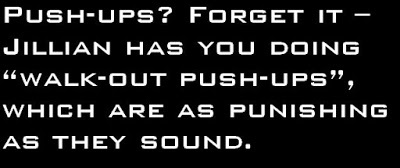 On the eleventh day, Level 2 begins, and it’s as much of a leap in difficulty as it is going from GCSE to A-level. Push-ups? Forget it – Jillian has you doing “walk-out push-ups”, which are as punishing as they sound. Of course, it’s for a reason – this modified classic works abs; shoulders; triceps; and chest, maximising calorie burn while encouraging muscle growth or retention. This is effectively Jillian’s signature: combination moves designed to burn calories and build/retain muscle in the most time-efficient way possible. Level 2’s cardio is trickier too – the “skaterz” move, for instance, is as much an exercise in balance as it is anything else. And certainly, balance is a recurring theme in this level – which is probably why it was my least favourite of the three. That, and Jillian’s penchant for deceptive lines like, “A few more,” which at one point I’d swear sees the dictionary definition of “a few” stretched to more than ten.
On the eleventh day, Level 2 begins, and it’s as much of a leap in difficulty as it is going from GCSE to A-level. Push-ups? Forget it – Jillian has you doing “walk-out push-ups”, which are as punishing as they sound. Of course, it’s for a reason – this modified classic works abs; shoulders; triceps; and chest, maximising calorie burn while encouraging muscle growth or retention. This is effectively Jillian’s signature: combination moves designed to burn calories and build/retain muscle in the most time-efficient way possible. Level 2’s cardio is trickier too – the “skaterz” move, for instance, is as much an exercise in balance as it is anything else. And certainly, balance is a recurring theme in this level – which is probably why it was my least favourite of the three. That, and Jillian’s penchant for deceptive lines like, “A few more,” which at one point I’d swear sees the dictionary definition of “a few” stretched to more than ten.
Level 3, though, is the business. Walk-out push-ups become the altogether more taxing travelling push-ups; lunges segue into full-blown, ankle-crushing plyometrics; pilates moves go nuclear as you go for an elbows-walk in plank position; you even get to graduate from stomach crunches to old-school sit-ups. It’s so taxing that, for the first time since starting the Shred, I was thankful that Jillian had one of her colleagues performing “modified” versions of the moves for me to emulate for a while, although I’d have preferred it if she’d have had a legitimate beginner on hand to do them instead of an über-lean blonde whose smile doesn’t even break, never mind her breaking a sweat. The cardio is made much more difficult again too as Jillian’s old and now familiar moves must be performed with hand weights – butt-kicks, with weights; shadow boxing squats, with weights… you get the idea. Again, I was wishing I’d got more hand weights ready to go in the living room, but this time for the opposite reason: jumping jacks with 5kg weights is downright dangerous.

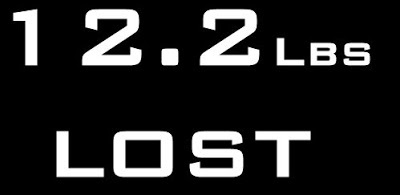 Minor grievances aside, an unexpected bonus of completing the 30 Day Shred for me has been that in every single level I’ve discovered some arduous new move to fold into my own strength training repertoire: Level 1’s side-lunge with shoulder raise is a great example of Jillian working multiple body parts at once; it’s great to feel your core tearing as you work your arms and legs. I’d rank it right up there with a deadlift. The same goes for Level 2’s V-squat and Level 3’s travelling push-ups. Efficiently brutal, both.
Minor grievances aside, an unexpected bonus of completing the 30 Day Shred for me has been that in every single level I’ve discovered some arduous new move to fold into my own strength training repertoire: Level 1’s side-lunge with shoulder raise is a great example of Jillian working multiple body parts at once; it’s great to feel your core tearing as you work your arms and legs. I’d rank it right up there with a deadlift. The same goes for Level 2’s V-squat and Level 3’s travelling push-ups. Efficiently brutal, both.
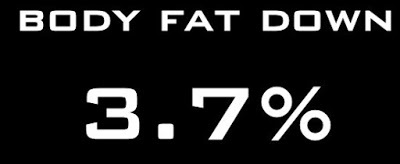 Inevitably though, what I’m really interested in is the tale of the tape. Over the thirty days, my body fat percentage has dropped significantly - it’s down by 3.7% on 2nd January - and my overall weight has come down by 12.2lbs. Best of all, I’ve lost 3.5” off my waist, and when working out in the gym with heavy weights I don’t any feel weaker. Interestingly, despite the minimal food intake, my biceps have actually grown, which is quite hard to fathom – it certainly stands as a testament to the 3-2-1 Interval System’s capacity to shred fat but not muscle. Its cover slogan isn’t doing the Shred justice – it should say, “Extreme Fat Loss!” rather than “Extreme Weight Loss!”
Inevitably though, what I’m really interested in is the tale of the tape. Over the thirty days, my body fat percentage has dropped significantly - it’s down by 3.7% on 2nd January - and my overall weight has come down by 12.2lbs. Best of all, I’ve lost 3.5” off my waist, and when working out in the gym with heavy weights I don’t any feel weaker. Interestingly, despite the minimal food intake, my biceps have actually grown, which is quite hard to fathom – it certainly stands as a testament to the 3-2-1 Interval System’s capacity to shred fat but not muscle. Its cover slogan isn’t doing the Shred justice – it should say, “Extreme Fat Loss!” rather than “Extreme Weight Loss!”  Click to enlarge the table above.
Click to enlarge the table above.
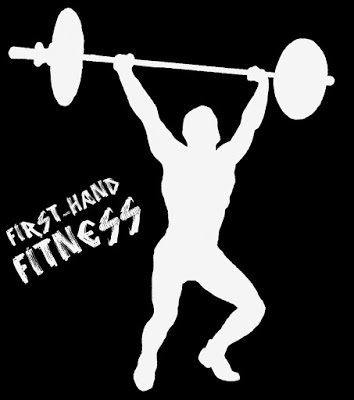 More disappointingly, I haven’t hatched a six-pack yet, though this is perhaps more a reflection on my Christmas food orgies than it is the 30 Day Shred series. I can feel the strong abs lurking underneath, and even see the shadow of the top four like milk teeth poised to burst through a baby’s gums, but the bottom two remain encased in a centimetre or so of apparently ineradicable thirty-something fat. I suspect that were I to persevere for another thirty to sixty days with the Shred, then the residual podge would be shredded – if I survived, that is.
More disappointingly, I haven’t hatched a six-pack yet, though this is perhaps more a reflection on my Christmas food orgies than it is the 30 Day Shred series. I can feel the strong abs lurking underneath, and even see the shadow of the top four like milk teeth poised to burst through a baby’s gums, but the bottom two remain encased in a centimetre or so of apparently ineradicable thirty-something fat. I suspect that were I to persevere for another thirty to sixty days with the Shred, then the residual podge would be shredded – if I survived, that is. Only one thing is for sure: this programme is intense.
Jillian Michaels’ 30 Day Shred is available on DVD in just about every British supermarket for about £3.00 at the moment, mired as they are in that opportunistic “Get Fit!” window between pedalling Christmas crap and Easter eggs. Alternatively, you can download all three levels from iTunes to watch on your Apple TV or iOS device for £4.99 – there’s no excuse for skipping a day if your workout’s on your iPhone! Levels are otherwise individually priced at £3.99 each, but if you buy Level 1 as a taster, for example, you can later buy the rest of the series for just a pound. The iTunes version also has the benefit of not being emblazoned with the worthless enticement, “Lose up to 20 pounds in 30 days!”, which, as any pedant will tell you, only means that you can’t be expected to lose any more than 20lbs. Dial it in and stuff your face, and you’ll probably lose fuck all without contradicting the tagline.
Published on January 31, 2016 02:08
January 24, 2016
The One-Listen Lowdown #4 | Night Thoughts by Suede
A man drowns in the waters of a deserted beach at dawn. As he fights for life, his mind plays out the events that lead him to be there.

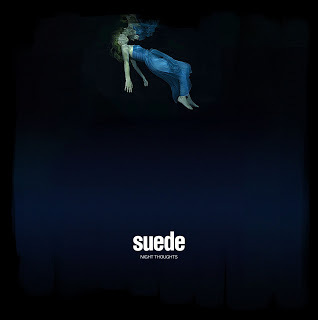 Night Thoughts is Suede’s first out-and-out concept piece. How many albums have a forty-eight-minute movie that sees the album played from start to finish as a promo video? None that I’m aware of. How many records see one song segue into the next, with themes and refrains returning as its lyrical narrative unfolds? Not many. Though still populated with memorable stand-alone numbers such as singles “Outsiders” and “Like Kids”, Night Thoughts is primarily an homage to grand movie scores, developing ideas gradually over twelve tracks rather than just the customary one. As a result, it’s the most cohesive Suede album of the lot – a more tightly-focused Dog Man Star, with all the grandeur thereto, but an even more squalid underbelly that at times borders on the odious.
Night Thoughts is Suede’s first out-and-out concept piece. How many albums have a forty-eight-minute movie that sees the album played from start to finish as a promo video? None that I’m aware of. How many records see one song segue into the next, with themes and refrains returning as its lyrical narrative unfolds? Not many. Though still populated with memorable stand-alone numbers such as singles “Outsiders” and “Like Kids”, Night Thoughts is primarily an homage to grand movie scores, developing ideas gradually over twelve tracks rather than just the customary one. As a result, it’s the most cohesive Suede album of the lot – a more tightly-focused Dog Man Star, with all the grandeur thereto, but an even more squalid underbelly that at times borders on the odious.
Musically, the twelve-track LP evokes the latter half of the preceding Bloodsports as well as the aforementioned Dog Man Star, but its sound is very much its own, combining Suede’s distinctive indie glamour sound with a full string section to create an abstract art-rock opera. Brooding from the start, the album is – almost – bookended by two linked tracks, “When You Are Young” and “When You Were Young”, both of which revel in the sort of symphonic grandeur that made “She’s in Fashion” such an indelible part of the fabric of the summer of ’99. Here, though, Brett Anderson’s falsetto is not admiring but haunting as, impenetrably, he sings of brothers’ guns and twisting on fists.

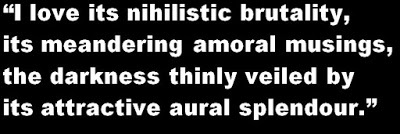 Lead single “Outsiders” is much more redolent of Suede’s highly regarded seven-inchers. A poor man’s “Obsessions” or a dark take on “Trash”, it’s the one track on the record where the Haywards Heath outfit play it safe. Catchy and radio-friendly, the track’s asocial angst bleeds into the altogether more interesting “No Tomorrow”, which also has all the hallmarks of a great single, but in addition boasts a level of depth that the previous track lacks. Question after question is framed (“How long will it take to break the plans that I never make?” / “How long will I shun the race and sit around in my denim shirts?” / “How long will it take to mend?”) as Anderson begs the listener to “fight the sorrow like there’s no tomorrow.”
Lead single “Outsiders” is much more redolent of Suede’s highly regarded seven-inchers. A poor man’s “Obsessions” or a dark take on “Trash”, it’s the one track on the record where the Haywards Heath outfit play it safe. Catchy and radio-friendly, the track’s asocial angst bleeds into the altogether more interesting “No Tomorrow”, which also has all the hallmarks of a great single, but in addition boasts a level of depth that the previous track lacks. Question after question is framed (“How long will it take to break the plans that I never make?” / “How long will I shun the race and sit around in my denim shirts?” / “How long will it take to mend?”) as Anderson begs the listener to “fight the sorrow like there’s no tomorrow.”
“Will you have courage of your tenderness?When the wolf is at your door, the child against your breast…”
First-listen highlight “Pale Snow” is up next. Its relative brevity belies its significance as the melodic and thematic cornerstone of the album. Mournful and morbid, its lyrics are amongst Night Thoughts’ most portentous as the singer’s questions collapse into defeat. “And they always get away. It never works out for me...” A longer, similarly rich but slightly more animated number follows in “I Don’t Know How to Reach You”. Its mellifluous melody is sodden with despair; “I’d steal a shadow for you, I’d love you like a knife…” It’s not just another post-lovesong in which a “dappled and still unshaved” protagonist laments his lost love – it’s laden with shock, lending it a sense of immediacy and veracity that sets it apart from others of the same ilk.
“There’s no room in the world for your kind of beauty.Yours are the names on tomorrow’s newspapers.Yours is the face of the desperate edge of now, when,like the snows of yesteryear, I’ll be gone from this Earth…”
Despite its prosaic title and upbeat tune, “What I’m Trying to Tell You” continues the moribund protagonist’s slow submission to death. Of all the album’s tracks, it most calls to mind early Suede – songs like “Stay Together” in which Anderson would momentarily stop singing and switch into eerie voiceover mode. However far they’ve come, it’s pleasing to see the band injecting aspects of their old style into new material – particularly when it’s so perfect a fit. “Tightrope” continues the old-school feel, calling to mind some of Dog Man Star’s most melancholy offerings (“You seem to love me when I am not around, but I have to go to ground…”), yet with the sort of torpid pace usually reserved for their second-tier, CD2 B-sides. Again, it’s an ideal match for Night Thoughts’ theatrical death march - measured and poignant. “Oh through the red lights, the amber, the silent mannequins, the crumpled mothers in their seats pull into morning through the stations, the smell of chemicals. Do I want you because you are out of reach?”
The next couple of tracks offer a brief respite from the drowning; a last lungful of air. “Learning to Be” provides a gentle moment of romantic reflection for the album’s nameless hero, “Like Kids” a post-punk rumination on the roads not taken. Is it hope or resignation is Anderson’s voice as he sings, “I try to step away, but I’m too scared to move, like I’m in love again”? I wonder.
“So I turn my attention to the bruise that’s on her fist, feel the pulse beneath her almost perfect wrist… And her keys are falling from her coat as I weave my fingers round her perfumed throat…”
Then we get to the really fucked-up shit. Upping the ante on Bloodsports ’ stalker anthem, “Always”, “I Can’t Give Her What She Wants” is an ode to attempted murder tenderly sung like a serenade. Gentle, thoughtful and laced with violence, it’s instantly one of the band’s greatest ever efforts – a daring, edgy masterpiece that calls to mind triumphs the like of smackhead split-up song, “The Living Dead”. Thankfully, age has given Suede the confidence not to relegate such controversial tunes to B-sides on interim singles.
“And who knows what we’ll become as we brave the weather. From the moment we are young, the fur and the feathers, the fox and the geese, the thrill of the chase…”
Growing out of the “When You Were Young” reprise, Night Thoughts’ story ends in “The Fur and the Feathers”, in which our drowning man ponders “meaning beyond the flesh” as he reflects on more worldly pleasures. It’s a predictable and slightly sub-par end to what is for the most part a bold and dazzling body of work, but I suppose it may prove to be a grower yet.
“Have Suede re-invented the album?” asks the Telegraph. Well, no - they haven’t. But they’ve released another bloody good one; one that’s markedly different from any of their previous efforts, and indeed most albums in general, but one that’s nonetheless a far cry from truly groundbreaking works such as The Wall and Sergeant Pepper’s Lonely Hearts’ Club Band. It’s too abstract to warrant comparison for the former; too unified a sound to compete with the letter. Yet I love its nihilistic brutality, its meandering amoral musings, the darkness thinly veiled by its attractive aural splendour. Come and play in the maze…
The Night Thoughts album is available to download from iTunes for £8.99, while the full-length promo movie is available to download from iTunes too in 1080p for £10.99. Amazon offer the album on CD for £9.99 plus delivery, and upon ordering you can immediately download the MP3 album at no extra charge. The MP3 album alone is the same price as iTunes’.

 Night Thoughts is Suede’s first out-and-out concept piece. How many albums have a forty-eight-minute movie that sees the album played from start to finish as a promo video? None that I’m aware of. How many records see one song segue into the next, with themes and refrains returning as its lyrical narrative unfolds? Not many. Though still populated with memorable stand-alone numbers such as singles “Outsiders” and “Like Kids”, Night Thoughts is primarily an homage to grand movie scores, developing ideas gradually over twelve tracks rather than just the customary one. As a result, it’s the most cohesive Suede album of the lot – a more tightly-focused Dog Man Star, with all the grandeur thereto, but an even more squalid underbelly that at times borders on the odious.
Night Thoughts is Suede’s first out-and-out concept piece. How many albums have a forty-eight-minute movie that sees the album played from start to finish as a promo video? None that I’m aware of. How many records see one song segue into the next, with themes and refrains returning as its lyrical narrative unfolds? Not many. Though still populated with memorable stand-alone numbers such as singles “Outsiders” and “Like Kids”, Night Thoughts is primarily an homage to grand movie scores, developing ideas gradually over twelve tracks rather than just the customary one. As a result, it’s the most cohesive Suede album of the lot – a more tightly-focused Dog Man Star, with all the grandeur thereto, but an even more squalid underbelly that at times borders on the odious.Musically, the twelve-track LP evokes the latter half of the preceding Bloodsports as well as the aforementioned Dog Man Star, but its sound is very much its own, combining Suede’s distinctive indie glamour sound with a full string section to create an abstract art-rock opera. Brooding from the start, the album is – almost – bookended by two linked tracks, “When You Are Young” and “When You Were Young”, both of which revel in the sort of symphonic grandeur that made “She’s in Fashion” such an indelible part of the fabric of the summer of ’99. Here, though, Brett Anderson’s falsetto is not admiring but haunting as, impenetrably, he sings of brothers’ guns and twisting on fists.

 Lead single “Outsiders” is much more redolent of Suede’s highly regarded seven-inchers. A poor man’s “Obsessions” or a dark take on “Trash”, it’s the one track on the record where the Haywards Heath outfit play it safe. Catchy and radio-friendly, the track’s asocial angst bleeds into the altogether more interesting “No Tomorrow”, which also has all the hallmarks of a great single, but in addition boasts a level of depth that the previous track lacks. Question after question is framed (“How long will it take to break the plans that I never make?” / “How long will I shun the race and sit around in my denim shirts?” / “How long will it take to mend?”) as Anderson begs the listener to “fight the sorrow like there’s no tomorrow.”
Lead single “Outsiders” is much more redolent of Suede’s highly regarded seven-inchers. A poor man’s “Obsessions” or a dark take on “Trash”, it’s the one track on the record where the Haywards Heath outfit play it safe. Catchy and radio-friendly, the track’s asocial angst bleeds into the altogether more interesting “No Tomorrow”, which also has all the hallmarks of a great single, but in addition boasts a level of depth that the previous track lacks. Question after question is framed (“How long will it take to break the plans that I never make?” / “How long will I shun the race and sit around in my denim shirts?” / “How long will it take to mend?”) as Anderson begs the listener to “fight the sorrow like there’s no tomorrow.”“Will you have courage of your tenderness?When the wolf is at your door, the child against your breast…”
First-listen highlight “Pale Snow” is up next. Its relative brevity belies its significance as the melodic and thematic cornerstone of the album. Mournful and morbid, its lyrics are amongst Night Thoughts’ most portentous as the singer’s questions collapse into defeat. “And they always get away. It never works out for me...” A longer, similarly rich but slightly more animated number follows in “I Don’t Know How to Reach You”. Its mellifluous melody is sodden with despair; “I’d steal a shadow for you, I’d love you like a knife…” It’s not just another post-lovesong in which a “dappled and still unshaved” protagonist laments his lost love – it’s laden with shock, lending it a sense of immediacy and veracity that sets it apart from others of the same ilk.
“There’s no room in the world for your kind of beauty.Yours are the names on tomorrow’s newspapers.Yours is the face of the desperate edge of now, when,like the snows of yesteryear, I’ll be gone from this Earth…”
Despite its prosaic title and upbeat tune, “What I’m Trying to Tell You” continues the moribund protagonist’s slow submission to death. Of all the album’s tracks, it most calls to mind early Suede – songs like “Stay Together” in which Anderson would momentarily stop singing and switch into eerie voiceover mode. However far they’ve come, it’s pleasing to see the band injecting aspects of their old style into new material – particularly when it’s so perfect a fit. “Tightrope” continues the old-school feel, calling to mind some of Dog Man Star’s most melancholy offerings (“You seem to love me when I am not around, but I have to go to ground…”), yet with the sort of torpid pace usually reserved for their second-tier, CD2 B-sides. Again, it’s an ideal match for Night Thoughts’ theatrical death march - measured and poignant. “Oh through the red lights, the amber, the silent mannequins, the crumpled mothers in their seats pull into morning through the stations, the smell of chemicals. Do I want you because you are out of reach?”
The next couple of tracks offer a brief respite from the drowning; a last lungful of air. “Learning to Be” provides a gentle moment of romantic reflection for the album’s nameless hero, “Like Kids” a post-punk rumination on the roads not taken. Is it hope or resignation is Anderson’s voice as he sings, “I try to step away, but I’m too scared to move, like I’m in love again”? I wonder.
“So I turn my attention to the bruise that’s on her fist, feel the pulse beneath her almost perfect wrist… And her keys are falling from her coat as I weave my fingers round her perfumed throat…”
Then we get to the really fucked-up shit. Upping the ante on Bloodsports ’ stalker anthem, “Always”, “I Can’t Give Her What She Wants” is an ode to attempted murder tenderly sung like a serenade. Gentle, thoughtful and laced with violence, it’s instantly one of the band’s greatest ever efforts – a daring, edgy masterpiece that calls to mind triumphs the like of smackhead split-up song, “The Living Dead”. Thankfully, age has given Suede the confidence not to relegate such controversial tunes to B-sides on interim singles.
“And who knows what we’ll become as we brave the weather. From the moment we are young, the fur and the feathers, the fox and the geese, the thrill of the chase…”
Growing out of the “When You Were Young” reprise, Night Thoughts’ story ends in “The Fur and the Feathers”, in which our drowning man ponders “meaning beyond the flesh” as he reflects on more worldly pleasures. It’s a predictable and slightly sub-par end to what is for the most part a bold and dazzling body of work, but I suppose it may prove to be a grower yet.
“Have Suede re-invented the album?” asks the Telegraph. Well, no - they haven’t. But they’ve released another bloody good one; one that’s markedly different from any of their previous efforts, and indeed most albums in general, but one that’s nonetheless a far cry from truly groundbreaking works such as The Wall and Sergeant Pepper’s Lonely Hearts’ Club Band. It’s too abstract to warrant comparison for the former; too unified a sound to compete with the letter. Yet I love its nihilistic brutality, its meandering amoral musings, the darkness thinly veiled by its attractive aural splendour. Come and play in the maze…
The Night Thoughts album is available to download from iTunes for £8.99, while the full-length promo movie is available to download from iTunes too in 1080p for £10.99. Amazon offer the album on CD for £9.99 plus delivery, and upon ordering you can immediately download the MP3 album at no extra charge. The MP3 album alone is the same price as iTunes’.
Published on January 24, 2016 13:26
January 20, 2016
Re-Awakening the Force #2 | Star Wars: Episode II - Attack of the Clones directed by George Lucas
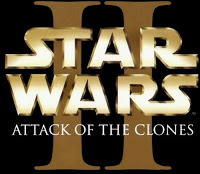 I love
Attack of the Clones
. By far the most underrated movie in the Star Wars saga to date,
Episode II
does everything that I wanted the prequels to do and more besides. It shows us Obi-Wan and Anakin fighting side by side as master and apprentice, with all the expected camaraderie and seniority squabbles thereto. It brings together the Skywalker twins’ parents in a duly overwrought, hearts-over-heads love story that all but seals Anakin’s fate. It completes the story of Palpatine’s rise to galactic dictator as the legendary Clone Wars begin in spectacular fashion. We even get to see Yoda fight.
I love
Attack of the Clones
. By far the most underrated movie in the Star Wars saga to date,
Episode II
does everything that I wanted the prequels to do and more besides. It shows us Obi-Wan and Anakin fighting side by side as master and apprentice, with all the expected camaraderie and seniority squabbles thereto. It brings together the Skywalker twins’ parents in a duly overwrought, hearts-over-heads love story that all but seals Anakin’s fate. It completes the story of Palpatine’s rise to galactic dictator as the legendary Clone Wars begin in spectacular fashion. We even get to see Yoda fight.
Furthermore, the film’s plot is one of the saga’s most ambitious, with Obi-Wan and Anakin’s investigation into an attempt on Padmé’s life leading the former to the heart of a mystery a decade in the making, and the latter into a passionate but turbulent relationship that will test his commitment to the Jedi Order, and ultimately serve as the catalyst for his Episode III heel turn. Both tantalising threads converge as Darth Sidious’s master plan finally comes to fruition and the galaxy erupts in an all-pervading war that, one day, his Galactic Empire will rise from the ashes of.
 “The thought of not being with you... I can’t breathe.”
“The thought of not being with you... I can’t breathe.”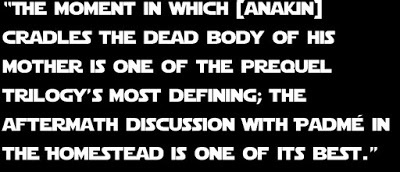 Clones
is most often criticised for George Lucas and Jonathan Hayles’ depiction of the Anakin / Padmé romance, not to mention Hayden Christensen’s performance as the troubled teen Romeo. I like both, for the most part. The screenwriters’ romantic dialogue is oddly formal, even bizarrely verbose at times, but this lends it the heightened feel of a play - something that I feel suits the nature of the story being told. As for Christensen, he comes off as moody and churlish, even Vader-monotonous at times - but that’s Anakin, particularly at this point in his life. He’s a loved-up teenager with attachment issues who feels like he’s being held back by his mentors - he’s supposed to be miserable.
Clones
is most often criticised for George Lucas and Jonathan Hayles’ depiction of the Anakin / Padmé romance, not to mention Hayden Christensen’s performance as the troubled teen Romeo. I like both, for the most part. The screenwriters’ romantic dialogue is oddly formal, even bizarrely verbose at times, but this lends it the heightened feel of a play - something that I feel suits the nature of the story being told. As for Christensen, he comes off as moody and churlish, even Vader-monotonous at times - but that’s Anakin, particularly at this point in his life. He’s a loved-up teenager with attachment issues who feels like he’s being held back by his mentors - he’s supposed to be miserable.
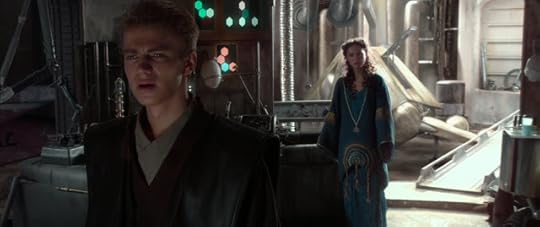 “Well I should be! I will be the most powerful Jedi ever!I will even learn to stop people from dying...”
“Well I should be! I will be the most powerful Jedi ever!I will even learn to stop people from dying...”Anakin’s return to Tatooine and search for his mother is also very well handled, again setting the stage perfectly for Episode III . The moment in which he cradles the dead body of his mother, his eyes wide and face contorted in horror and rage as John Williams’ score builds to a crescendo, is one of the prequel trilogy’s most defining; the aftermath discussion with Padmé in the Homestead is one of its best. In the latter, Christensen really shows us what he can do as Anakin’s tear-stained rage and remorse boil over into a chilling monologue that walks a terrifying tightrope between despair and determination. Years later, he would say to his son, “There is no conflict…” - but here there clearly is, and it’s arguably a much more fascinating area to explore.
 Obi-Wan’s thread of the narrative is more traditional in the outer-space swashbuckling sense, but it’s also unusual in that in casts him in the role of detective. It’s great fun to see him turn to greasy-spoon friends and frosty Jedi librarians as he tries to piece together a puzzle that will lead him to an apparently Jedi-ordered clone army, conveniently ready-made to meet the rising threat of the Separatists. Such labyrinthine plotting is a marked contrast to the more straightforward films of the ’70s and ’80s, and really helps to sell the scope of the Sith’s master plan. Where it falls down, to a certain extent, is in the movie’s - and indeed the prequel trilogy’s - resolution, which isn’t explicit enough for many viewers. Was the army-ordering Syfo-Dyas an agent of the Sith, or Count Dooku in disguise? And how much does Dooku know of Darth Sidious’s true intentions? I don’t mind having to turn to spin-off media to elucidate, but the films should be able to stand alone, and they only manage to just barely.
Obi-Wan’s thread of the narrative is more traditional in the outer-space swashbuckling sense, but it’s also unusual in that in casts him in the role of detective. It’s great fun to see him turn to greasy-spoon friends and frosty Jedi librarians as he tries to piece together a puzzle that will lead him to an apparently Jedi-ordered clone army, conveniently ready-made to meet the rising threat of the Separatists. Such labyrinthine plotting is a marked contrast to the more straightforward films of the ’70s and ’80s, and really helps to sell the scope of the Sith’s master plan. Where it falls down, to a certain extent, is in the movie’s - and indeed the prequel trilogy’s - resolution, which isn’t explicit enough for many viewers. Was the army-ordering Syfo-Dyas an agent of the Sith, or Count Dooku in disguise? And how much does Dooku know of Darth Sidious’s true intentions? I don’t mind having to turn to spin-off media to elucidate, but the films should be able to stand alone, and they only manage to just barely.
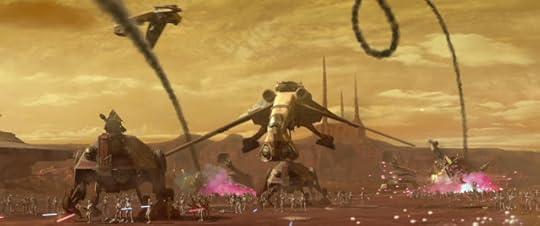 The movie’s climax is unreservedly spectacular - it’s thrilling to see a group of Jedi going to war for the first time, even if it means that we only see several small lightsaber duels instead of one almighty one. Amongst them, of course, is Yoda’s first on-screen show of swordsmanship; something teased by Obi-Wan at the start of the movie and delivered in style by the saga’s first CG Yoda. The larger clones versus droids backdrop is impressive too, particularly with Christopher Lee’s underrated Count Dooku and his Flash Gordon-inspired cadre of Confederacy leaders presiding over the battle from high above. My only niggles are that both Anakin and Jango Fett are defeated a little too easily for my tastes, though in the case of the latter it does at least give us a haunting moment in which the young Boba picks up his father’s decapitated head, mirroring Anakin’s earlier scene with his mother and to the same end.
The movie’s climax is unreservedly spectacular - it’s thrilling to see a group of Jedi going to war for the first time, even if it means that we only see several small lightsaber duels instead of one almighty one. Amongst them, of course, is Yoda’s first on-screen show of swordsmanship; something teased by Obi-Wan at the start of the movie and delivered in style by the saga’s first CG Yoda. The larger clones versus droids backdrop is impressive too, particularly with Christopher Lee’s underrated Count Dooku and his Flash Gordon-inspired cadre of Confederacy leaders presiding over the battle from high above. My only niggles are that both Anakin and Jango Fett are defeated a little too easily for my tastes, though in the case of the latter it does at least give us a haunting moment in which the young Boba picks up his father’s decapitated head, mirroring Anakin’s earlier scene with his mother and to the same end.
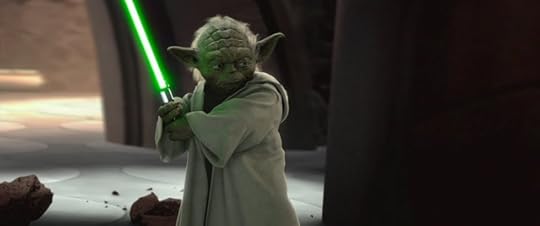
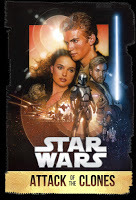 It’s become fashionable to lambaste all the prequels despite
II
and
III
’s evident quality, but I’ve never been one for fashion. By turns thrilling and haunting,
Attack of the Clones
is an overlooked gem in the Star Wars saga - one that, in time, I hope starts to get the recognition that it deserves.
It’s become fashionable to lambaste all the prequels despite
II
and
III
’s evident quality, but I’ve never been one for fashion. By turns thrilling and haunting,
Attack of the Clones
is an overlooked gem in the Star Wars saga - one that, in time, I hope starts to get the recognition that it deserves. Under its newly-shortened title Star Wars: Attack of the Clones, the home video edition of this movie (featuring an extended scene in the Homestead between Anakin and Padmé) is available to download from iTunes in 1080p HD for £13.99. A Blu-ray is also available, with today’s cheapest retailer being Zavvi , who are selling the steelbook for £16.99. The theatrical version of the movie has never been commercially released - not even on DVD.
Published on January 20, 2016 12:31
January 19, 2016
Book Review | Star Wars: Tarkin by James Luceno
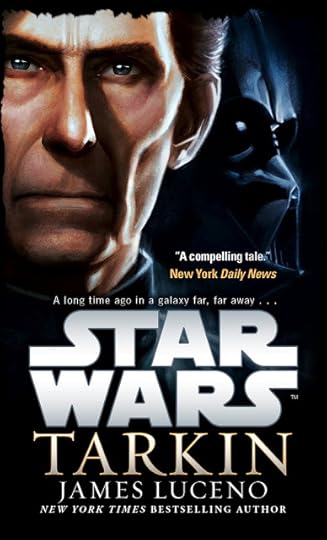 Tarkin, by esteemed Star Wars Expanded Universe veteran James Luceno, has been my first venture into Disney’s all-new Star Wars literary canon. With all pre-Disney Star Wars books now seemingly retconned and rebranded as “Star Wars Legends”, even those yet (and probably unlikely) to be contradicted by Disney-era media, I’ve been both surprised and delighted to find that Tarkin is actually beautifully redolent of the author’s suddenly redundant, but still spellbinding as ever, bibliography -
Labyrinth of Evil
and Dark Lord: The Rise of Darth Vader especially so.
Tarkin, by esteemed Star Wars Expanded Universe veteran James Luceno, has been my first venture into Disney’s all-new Star Wars literary canon. With all pre-Disney Star Wars books now seemingly retconned and rebranded as “Star Wars Legends”, even those yet (and probably unlikely) to be contradicted by Disney-era media, I’ve been both surprised and delighted to find that Tarkin is actually beautifully redolent of the author’s suddenly redundant, but still spellbinding as ever, bibliography -
Labyrinth of Evil
and Dark Lord: The Rise of Darth Vader especially so.Indeed, Tarkin is clear a reflection of Luceno’s late 2005 novel in particular - the only real difference is its subject. This isn’t a criticism; the author’s formula is as effective now as it was a decade ago. This time, rather than opening a window into the tortured mind of the recently-crippled Darth Vader, here Luceno turns his attention towards the grand moff of the Galactic Empire; the sector governor and tactical mastermind to whom even Vader would defer in the original Star Wars movie, Wilhuff Tarkin.
Despite some excellent exposure in Star Wars: The Clone Wars , and even a fleeting cameo at the end of Revenge of the Sith , before reading this book I knew precious little about the character whom Peter Cushing’s cold and clipped performance would make famous besides that gleamed from the silver screen. Set around the time of the Star Wars Rebels TV series, Luceno’s main narrative sees its protagonist constantly harking back to the events that forged him. We learn of his colonial upbringing in the Outer Rim, the literal ordeals / rites of passage that his ruthless family made him suffer through, the beginning of his military career and Sheev Palpatine’s subsequent steering it towards politics. Entire episodes from Tarkin’s youth are played out with colour and verve - he brings cybernetic fallen princesses turned pirates to heel, turns his governance of nature into the governance of his world; he even snubs Count Dooku over dinner on the eve of war’s outbreak, and in so doing saves his world. Each tale, each piece of the grand tapestry, feeds into the decisions Tarkin makes as he deals with events in the present - events that cast him in the unusual role of victim rather than perpetrator.

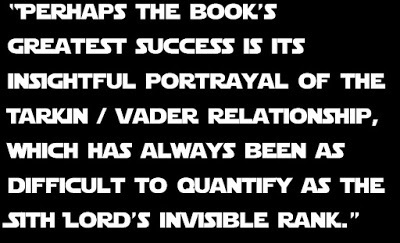 For me, the illicit joy of this book is its deceptively soft focus - its ability to carry along its readers at a frantic pace without ever allowing them pause to consider that its two chief protagonists are, in fact, antagonists, and that its “good guys” are really the perpetrators of the grand theft cosmos on which the plot builds. Reading about Tarkin; about Vader; even about the Emperor sat atop Coruscant in his opulent palace, their goals and doctrines unwittingly infect you as you read. Somehow, you want them to win.
For me, the illicit joy of this book is its deceptively soft focus - its ability to carry along its readers at a frantic pace without ever allowing them pause to consider that its two chief protagonists are, in fact, antagonists, and that its “good guys” are really the perpetrators of the grand theft cosmos on which the plot builds. Reading about Tarkin; about Vader; even about the Emperor sat atop Coruscant in his opulent palace, their goals and doctrines unwittingly infect you as you read. Somehow, you want them to win. Perhaps the book’s greatest success though is its understated, but still most insightful, portrayal of the Tarkin / Vader relationship, which has always been as difficult to quantify as the Sith Lord’s invisible rank. Who answers to whom? Even the Emperor washes his hands of the issue here, and as matters progress it becomes apparent that the question is immaterial: Vader and Tarkin are a partnership, and it’s implied that they each know it. Vader has his skills, Tarkin has his, and to their mutual credit they each know when to give a free rein to the other. It makes for a thrilling, page-turning read as in concert they must hunt down the turncoats who’ve stolen Tarkin’s ship, the Carrion Spike, and turned its might against the Empire in one of the earliest acts of rebellion. What makes this chase all the more alluring are the moments in which Tarkin stops to try to look behind those obsidian orbs that shroud Vader’s eyes in an attempt to confirm his gut feeling that the cybernetic monstrosity with whom he feels such unusual and begrudging kinship was once his only real Jedi ally from the Clone Wars, Anakin Skywalker.
Perhaps the book’s greatest success though is its understated, but still most insightful, portrayal of the Tarkin / Vader relationship, which has always been as difficult to quantify as the Sith Lord’s invisible rank. Who answers to whom? Even the Emperor washes his hands of the issue here, and as matters progress it becomes apparent that the question is immaterial: Vader and Tarkin are a partnership, and it’s implied that they each know it. Vader has his skills, Tarkin has his, and to their mutual credit they each know when to give a free rein to the other. It makes for a thrilling, page-turning read as in concert they must hunt down the turncoats who’ve stolen Tarkin’s ship, the Carrion Spike, and turned its might against the Empire in one of the earliest acts of rebellion. What makes this chase all the more alluring are the moments in which Tarkin stops to try to look behind those obsidian orbs that shroud Vader’s eyes in an attempt to confirm his gut feeling that the cybernetic monstrosity with whom he feels such unusual and begrudging kinship was once his only real Jedi ally from the Clone Wars, Anakin Skywalker.
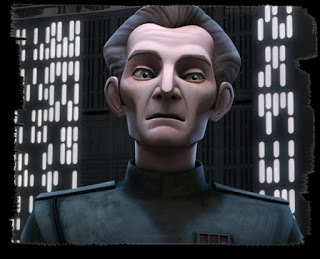 By turns fast, furious and flagrant, Tarkin lifts the veil not only on its eponymous protagonist but also on his fellow agents of evil and the inner workings of the Galactic Empire that they now must defend. It’s right up there with Luceno’s finest efforts from this era, in my view, with which it sits remarkably well - a complement to, rather than replacement for.
By turns fast, furious and flagrant, Tarkin lifts the veil not only on its eponymous protagonist but also on his fellow agents of evil and the inner workings of the Galactic Empire that they now must defend. It’s right up there with Luceno’s finest efforts from this era, in my view, with which it sits remarkably well - a complement to, rather than replacement for.Tarkin is available to download from iTunes for £4.99. If you think it’d be more fitting to download the book from the imperial might of Amazon , though, the listed price is still the same but you’re unlikely to find Amazon’s gift cards discounted as you will iTunes’, so iTunes remains the cheaper option. Alternatively, if deforestation and clutter is your thing, Amazon are flogging a paperback for £6.29 plus delivery.
Published on January 19, 2016 13:54
January 3, 2016
Audio Drama Review | Doctor Who: The War Doctor - Only the Monstrous written by Nicholas Briggs

 There has never been a more exciting time to be a Big Finish listener. Last year, following the collapse of fellow BBC licensee AudioGo, Big Finish’s sudden expansion of their own Doctor Who licence led to what felt like a seemingly never-ending precession of mind-blowing announcements concerning upcoming releases featuring characters and elements from the new series, the most thrilling of which was The War Doctor - Only the Monstrous - a full-cast mini-series starring John Hurt as the... um... ninth incarnation of the Time Lord formerly known as the Doctor (let’s stick with the “War Doctor” for ease of reference, if not accuracy).
There has never been a more exciting time to be a Big Finish listener. Last year, following the collapse of fellow BBC licensee AudioGo, Big Finish’s sudden expansion of their own Doctor Who licence led to what felt like a seemingly never-ending precession of mind-blowing announcements concerning upcoming releases featuring characters and elements from the new series, the most thrilling of which was The War Doctor - Only the Monstrous - a full-cast mini-series starring John Hurt as the... um... ninth incarnation of the Time Lord formerly known as the Doctor (let’s stick with the “War Doctor” for ease of reference, if not accuracy).On the show’s fiftieth anniversary, The Day of the Doctor finally lifted the veil on the Last Great Time War that had been teased for so long. Unfortunately, in rewriting history to make the Doctor “the man who won the Time War”, rather than the altogether more interesting tortured soul who had to kill his own kind to save all creation, Steven Moffat all but killed my interest in the once quasi-mythical conflict, and indeed the ongoing TV series from that point onwards. Yet seeing the stunning cover for Only the Monstrous cut straight through my disenchantment. For the first time in two years, Doctor Who had piqued my interest.
I was nonetheless a little surprised to see Nicholas Briggs’ name on the cover as the three hour-long plays’ writer. Whilst predictable in the sense that he’s the company’s executive producer and has a proven - no, stellar - record in box sets such as this one, in the past he’d always emphatically slammed the idea of exploring the Last Great Time War directly due to the intangible nature of the conflict. I remember in particular one mocking rant in which he cried, “Launch timonic missiles!” in a sarcastic voice, before going on to question how one could possibly dramatise such an unfathomable war in any sort of meaningful way. I disagreed with him as to the impossibility of the mechanics, but not with the other, more important, limb of his argument: that the mystery of the Time War was better left intact. Having since starred in The Day of the Doctor , however, and thus experienced first-hand Steven Moffat’s explosive - if surprisingly prosaic - take on a temporal battleground, Briggs had his template for Time War tales, not to mention his excuse for writing them. With the mystery gone, he might as well take his love of old British war films (“…some of my favourite things,” he says in Vortex #82) and transpose it into the Whoniverse.

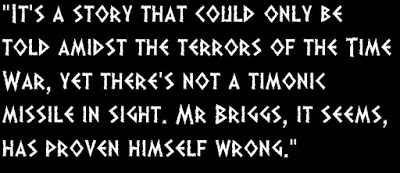 The result is perhaps a little underwhelming at first, given the thunderous expectations heaped upon this release; however, it’s important to be mindful this isn’t a one-off, theatrically-released, 3-D anniversary special but the start of a new era for a new incarnation of the Doctor, and as such its slow burn is essential. In fact, the set’s first episode, “The Innocent”, subverted my expectations in the most interesting and intimate of ways. Sensibly picking up long after
The Night of the Doctor
, and thus taking full advantage of the centuries of suffering buried in Hurt’s legendarily craggy voice, Briggs’ introverted opener draws listeners right into the heart of a particularly fan-pleasing battle before the rug is pulled from under them and the injured War Doctor finds himself far from the front lines on a comparatively primitive world assailed by its own genocidal enemies (Dalek Empire super-Scot Mark McDonnell leading the charge). Tending to the wounded warrior is Lucy Briggs-Owen’s soft-spoken Rejoice, a would’ve-been / should’ve-been companion whose relationship with “Captain Grumpy” will have far-reaching consequences for both her and her people.
The result is perhaps a little underwhelming at first, given the thunderous expectations heaped upon this release; however, it’s important to be mindful this isn’t a one-off, theatrically-released, 3-D anniversary special but the start of a new era for a new incarnation of the Doctor, and as such its slow burn is essential. In fact, the set’s first episode, “The Innocent”, subverted my expectations in the most interesting and intimate of ways. Sensibly picking up long after
The Night of the Doctor
, and thus taking full advantage of the centuries of suffering buried in Hurt’s legendarily craggy voice, Briggs’ introverted opener draws listeners right into the heart of a particularly fan-pleasing battle before the rug is pulled from under them and the injured War Doctor finds himself far from the front lines on a comparatively primitive world assailed by its own genocidal enemies (Dalek Empire super-Scot Mark McDonnell leading the charge). Tending to the wounded warrior is Lucy Briggs-Owen’s soft-spoken Rejoice, a would’ve-been / should’ve-been companion whose relationship with “Captain Grumpy” will have far-reaching consequences for both her and her people. This inspired setup gives Sir John the opportunity to make his mark in a relatively quiet and personal setting, showing us aspects of his character that
The Day of the Doctor
didn’t have the time to dwell upon. Quite rightly, Briggs is keen to stress that, despite his renunciation of his name and his apparent embracing of an alarming “ends justify the means” mentality, the War Doctor is still the Doctor whether he likes it or not. This much is borne out very quickly, as the self-loathing and battle-weary Time Lord finds himself inclined to aid the peaceful underdogs in what appears to be the Time War in microcosm. Even more so than on television, the heroism of the War Doctor is palpable - he just can’t see it himself.
This inspired setup gives Sir John the opportunity to make his mark in a relatively quiet and personal setting, showing us aspects of his character that
The Day of the Doctor
didn’t have the time to dwell upon. Quite rightly, Briggs is keen to stress that, despite his renunciation of his name and his apparent embracing of an alarming “ends justify the means” mentality, the War Doctor is still the Doctor whether he likes it or not. This much is borne out very quickly, as the self-loathing and battle-weary Time Lord finds himself inclined to aid the peaceful underdogs in what appears to be the Time War in microcosm. Even more so than on television, the heroism of the War Doctor is palpable - he just can’t see it himself.As the story moves into its second and third instalments it picks up a lot of pace, but, pleasingly, not at the expense of substance. Briggs’ plot cleverly pits the Doctor and an older Rejoice (now played by the perpetually regal Carolyn Seymour, veteran of countless 24th-century Star Trek episodes) against Seratrix, a dangerous Time Lord idealist who’s hell-bent on appeasing the Daleks in a desperate bid for peace. This unexpected anti-antagonist highlights the gulf between the Time Lord’s warrior incarnation - the ‘War Doctor’, if you will - and the Doctors either side of it. In any other story, and against almost any other enemy, the Doctor would be the one advocating peace. It’s a story that could only be told amidst the terrors of the Time War, yet there’s not a timonic missile in sight. Mr Briggs, it seems, has proven himself wrong.
Regrettably though, the Big Finish exec does succumb to the temptation to make his Time Lord turncoat morally bankrupt - the fascinating parallels with the Doctors dissipate once the accepted cost of the Dalek collaborator’s plot becomes plain. For me, the story would have been more compelling had Seratrix been less ruthless and more Doctor-like, as in the end it is questions of morality that make the Time War with its non-Doctor Doctor so fertile a field for storytelling.
 And, inevitably, I’m a little disappointed that Briggs avoids Gallifrey, for the most part, limiting the War Doctor’s dealings with his own people to Jacqueline Pearce’s (Blake’s 7, Doctor Who: The Two Doctors) Cardinal Ollistra. This was to be expected, of course, given Big Finish’s ongoing Gallifrey series; 2017’s planned eighth Doctor Time War box set; and Briggs’ understandable reservations about tying up continuity, for fear that Steven Moffat and company will just merrily contradict whatever Big Finish establish in the future, should it serve the TV series for them to do so. This is still frustrating as fan, though, as questions of the Gallifreyan presidency; of Ace; of the Master; and of the last-seen-in-another-universe Rassilon; are all ones that we’ve waited a long, long time for answer to. And if Big Finish can get a legend like John Hurt on board with relative ease, then maybe they can ensnare Sir Derek Jacobi and/or Timothy Dalton too? I’d pay good money to hear Dalton reprise his role as Rassilon in a handover from Don Warrington, pipe-dream though it may be.
And, inevitably, I’m a little disappointed that Briggs avoids Gallifrey, for the most part, limiting the War Doctor’s dealings with his own people to Jacqueline Pearce’s (Blake’s 7, Doctor Who: The Two Doctors) Cardinal Ollistra. This was to be expected, of course, given Big Finish’s ongoing Gallifrey series; 2017’s planned eighth Doctor Time War box set; and Briggs’ understandable reservations about tying up continuity, for fear that Steven Moffat and company will just merrily contradict whatever Big Finish establish in the future, should it serve the TV series for them to do so. This is still frustrating as fan, though, as questions of the Gallifreyan presidency; of Ace; of the Master; and of the last-seen-in-another-universe Rassilon; are all ones that we’ve waited a long, long time for answer to. And if Big Finish can get a legend like John Hurt on board with relative ease, then maybe they can ensnare Sir Derek Jacobi and/or Timothy Dalton too? I’d pay good money to hear Dalton reprise his role as Rassilon in a handover from Don Warrington, pipe-dream though it may be.For now, though, the promise of more from the mercurial John Hurt and the innovative Nicholas Briggs is more than enough enticement to ensure the success of subsequent box sets. Just like Paul McGann before him, the Alien superstar is using Big Finish to bring his incarnation of the Doctor into the same stratosphere as the better-known, full-time TV Doctors. But, of course, Hurt has an edge that his chronological predecessor didn’t - his War Doctor is unique, in attitude if not necessarily in deed, and his theatre isn’t one of adventure – it’s one of war.
Doctor Who: The War Doctor – Only the Monstrous is available to download from the Big Finish website for just £20.00 until 29th February 2016, at which time the price will rise. If you are prepared to make an additional £1.50 postage contribution, select the ‘CD’ option instead of ‘Download’ to receive a magnificent four-CD box set in addition to the download.
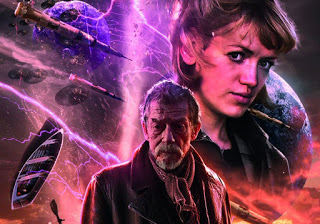
Published on January 03, 2016 12:04
E.G. Wolverson's Blog
- E.G. Wolverson's profile
- 52 followers
E.G. Wolverson isn't a Goodreads Author
(yet),
but they
do have a blog,
so here are some recent posts imported from
their feed.



